Kazakhstan
A look At Central Asia’s Largest Country, Including Cosmopolitan Almaty & Astana, a.k.a. The Dubai of the Steppes, The New Futuristic Capital On The Northern Windswept Kazakh Steppe
War Memorial, Panfilov Park, Almaty, Kazakhstan. February 13, 2015
Kazakhstan (February 12-22 2015)
Recapping a winter trip to Kazakhstan, Central Asia’s largest country, including cosmopolitan Almaty, the leafy former capital & Central Asia’s largest city, & Astana, a.k.a. the Dubai of the Steppes, the new futuristic capital on the northern windswept Kazakh steppe, the petrodollar boom showcase city for the whole Central Asian region.
Republic of Kazakhstan
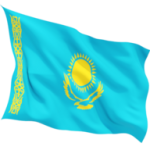 Kazakhstan maybe better known in popular culture as the home of the fictional Sacha Baron Cohen character Borat, but beyond that it’s known for its vast, endless array of winding, featureless steppe, realm of the ancient Kazakh nomads that spread out for hundreds of kilometres in all directions, & the abundant mineral reserves that lay beneath it all, & which the county is using to finance the future. This Goliath country is the largest of the former Soviet Central Asian states, the largest landlocked country in the world and the 9th largest overall – it’s more than twice the size of the 4 other ex-Soviet Central Asian states of Turkmenistan, Uzbekistan, Kyrgyzstan & Tajikistan combined and bigger even than Western Europe. Once a land of nomadic tribes, the area was conquered by Russia in the 18th century & it became a Soviet Republic in 1936 before achieving independence in 1991; Kazakhstan was the last of the 5 Central Asian states to declare independence & cut its ties with Moscow. Boasting abundant oil, natural gas & mineral reserves, the country is the richest & most economically developed of the 5 ‘stans & at present is in the midst of a petrodollar building boom, constructing everything from high-speed railways to shiny metro systems to the building of a new capital city, Astana on the northern steppe, a showpiece city of futuristic architecture fit for the 21st Century & beyond. There’s no doubt Kazakhstan is going places & it’s people becoming more prosperous – the country is already labelled a middle-income country and is already classified with a high human development index.
Kazakhstan maybe better known in popular culture as the home of the fictional Sacha Baron Cohen character Borat, but beyond that it’s known for its vast, endless array of winding, featureless steppe, realm of the ancient Kazakh nomads that spread out for hundreds of kilometres in all directions, & the abundant mineral reserves that lay beneath it all, & which the county is using to finance the future. This Goliath country is the largest of the former Soviet Central Asian states, the largest landlocked country in the world and the 9th largest overall – it’s more than twice the size of the 4 other ex-Soviet Central Asian states of Turkmenistan, Uzbekistan, Kyrgyzstan & Tajikistan combined and bigger even than Western Europe. Once a land of nomadic tribes, the area was conquered by Russia in the 18th century & it became a Soviet Republic in 1936 before achieving independence in 1991; Kazakhstan was the last of the 5 Central Asian states to declare independence & cut its ties with Moscow. Boasting abundant oil, natural gas & mineral reserves, the country is the richest & most economically developed of the 5 ‘stans & at present is in the midst of a petrodollar building boom, constructing everything from high-speed railways to shiny metro systems to the building of a new capital city, Astana on the northern steppe, a showpiece city of futuristic architecture fit for the 21st Century & beyond. There’s no doubt Kazakhstan is going places & it’s people becoming more prosperous – the country is already labelled a middle-income country and is already classified with a high human development index.
– Lonely Planet
Read all postings from the road in chronological order or jump to specific postings using these links.
Border Crossing & Introduction to Kazakhstan || Almaty 1 || Medeu & Shymbulak || Astana || Almaty 2
BORDER CROSSING & INTRODUCTION TO KAZAKHSTAN
Posts From The Kazak Road (Displayed In Chronological Order)
Date || February 12, 2015
Location || Almaty, Kazakhstan ( )
)
It’s good to be out of China. I’ve just arrived in Almaty, Kazakhstan, my first stop in Central Asia. A new city in a new region. It’s early days of course but I’ve a feeling I’m going to like Kazakhstan, the largest (by some way) of the 5 ex-Soviet Central Asian states. It was all very informal with the lady at the Kazakh immigration desk at the border crossing with China. Even though she had my passport in her hand she still asked me my age. ‘Thirty-nine‘ I said, in reply to which she said I didn’t look ‘that old’ before wishing me ‘good luck.’ Nice. Ten yards further on and the customs guy was delighted to see me, his ear to ear grin showing his mouth full of gold teeth. ‘Irlanda!’, he proclaimed after taking my passport to give it the customary once-over. This was swiftly followed by ‘Glasgow?’ – he corrected himself before I had the chance to, looking to me somewhat apologetically while going on to assure me he knew of Ireland by uttering the words ‘Robbie Keane’. Oh yes, Robbie’s a legend alright, even in these distant quarters.
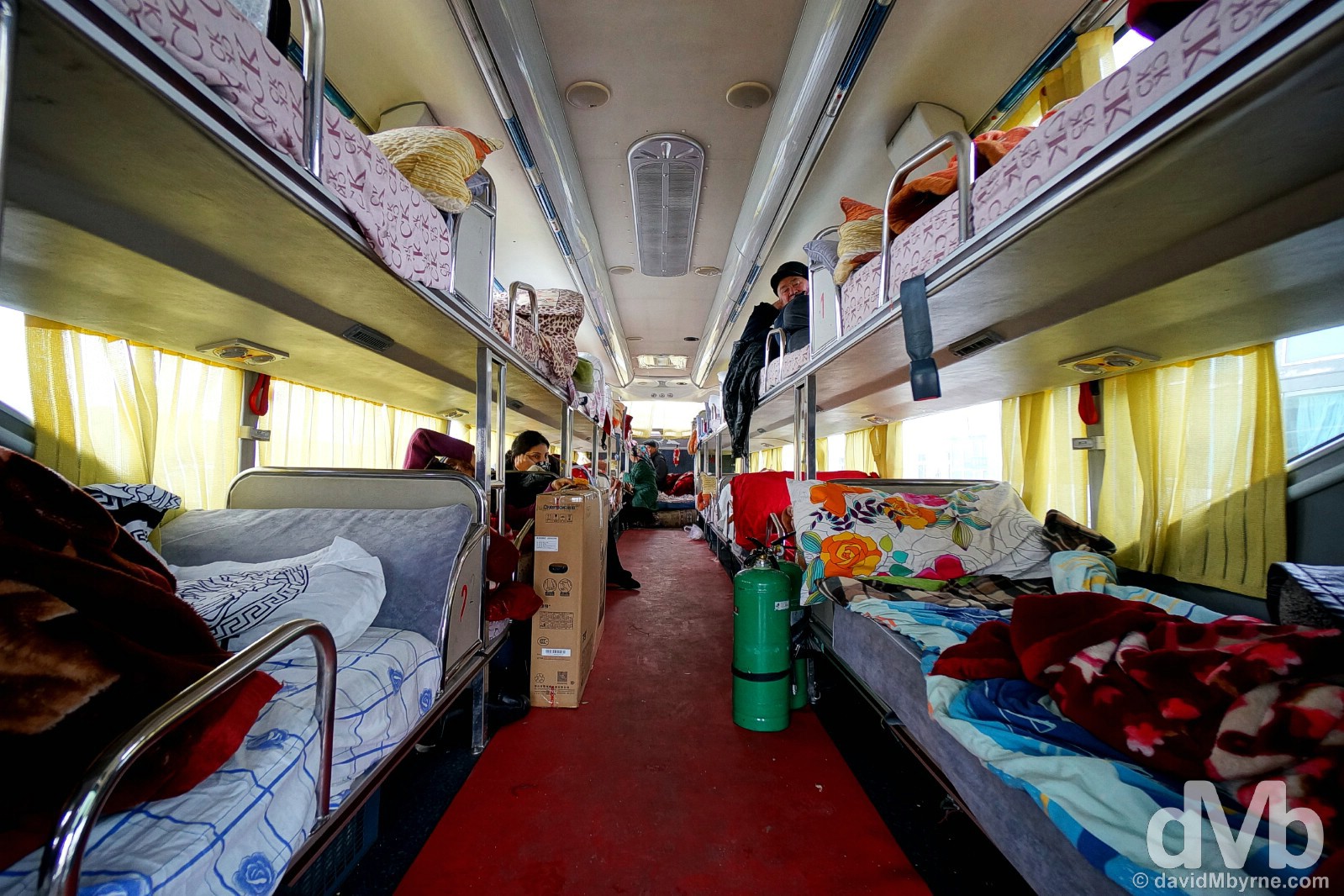
The 24-hour sleeper bus from Urumqi in China to my present location of Almaty, Kazakhstan, did actually take 24 hours but I estimate about half of that was actual transit time; the other half was taken up by numerous rest stops & elongated border & customs formalities, first exiting China & then entering Kazakhstan. It wasn’t an uncomfortable trip, it just felt long & I spent most of it in my bunk (that’s mine, top-left). Needless to say I was the only foreigner on the bus, the lone English speaker among a party of 25+ Russian speaking Kazakhs returning home from what looked like a shopping trip in Urumqi given the quantity of goods they were transporting. I took this picture shortly after crossing the border on the Kazakh side of the Khorgos border crossing between China & Kazakhstan. February 12, 2015.
More to come from Kazakhstan.
ALMATY 1
Date || February 19, 2015
Location || Almaty, Kazakhstan ( )
)
I’ve been in Kazakhstan for a while now. This is day 8 already, and because I have to sit around waiting for visas for the rest of the region I’ll be here for a few more days to come. That should give me ample time to get through the backlog of pictures I’ve accumulated from my time here thus far. First up, pictures from the first three days in the southern Kazakh city of Almaty, my first stop in the country and the Central Asian region.
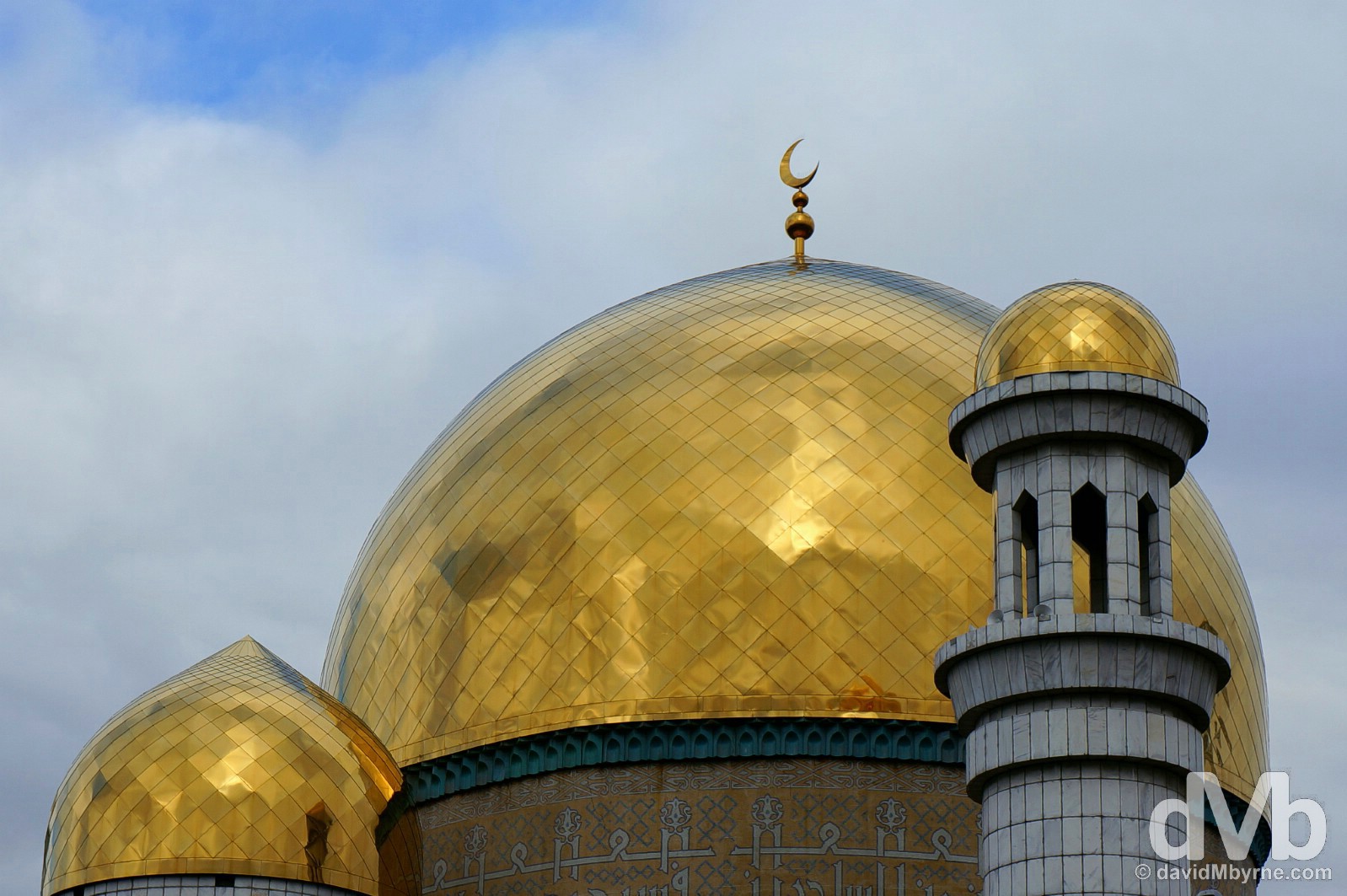
Over 80% of the 65 million people in Central Asia are Muslim, a faith that has had a resurgence in the region since the fall of the USSR & Kasakh independence in 1991. But you wouldn’t think that here in Almaty, Central Asia’s most cosmopolitan city. This is the gorgeous gold domes of the city’s Central Mosque, a multitowered mosque built in 1999 and with a capacity for 3000 worshippers & the only obviously Islamic building I’ve seen from days of walking the city’s streets. An Almaty & Central Asian anomaly no doubt as I expect lots more Islamic architecture to come as I travel through the region in the coming weeks. Just a heads up if you’re going to hang around for the ride. Central Mosque, Almaty, Kazakhstan. February 13, 2015.
Almaty
Located in the extreme south of the country near the border with Kyrgyzstan, Almaty is home to about 10% of Kazakhstan’s 17 million population. The former capital during the Kazakh SSR (Soviet Socialist Republic) days, a status it lost to Astana on the northern steppes in December 1998, it is still, for now at least, Kazakhstan’s commercial, social & financial centre. It’s a big place (not Chinese city big, but big nonetheless), the largest city not only in Kazakhstan but also in the whole Central Asian region, and walking from place to place along its grid of long, broad, leafy avenues takes time. A cosmopolitan city, some claim it to be European-esque. Maybe it is but to me it’s 100% unmistakably Russian – the people on the streets are outwardly dour, the script confusingly Cyrillic & the architecture imposing, boxy, ugly & downright boring. Yep, it’s still typically soviet, even 24 years after independence.
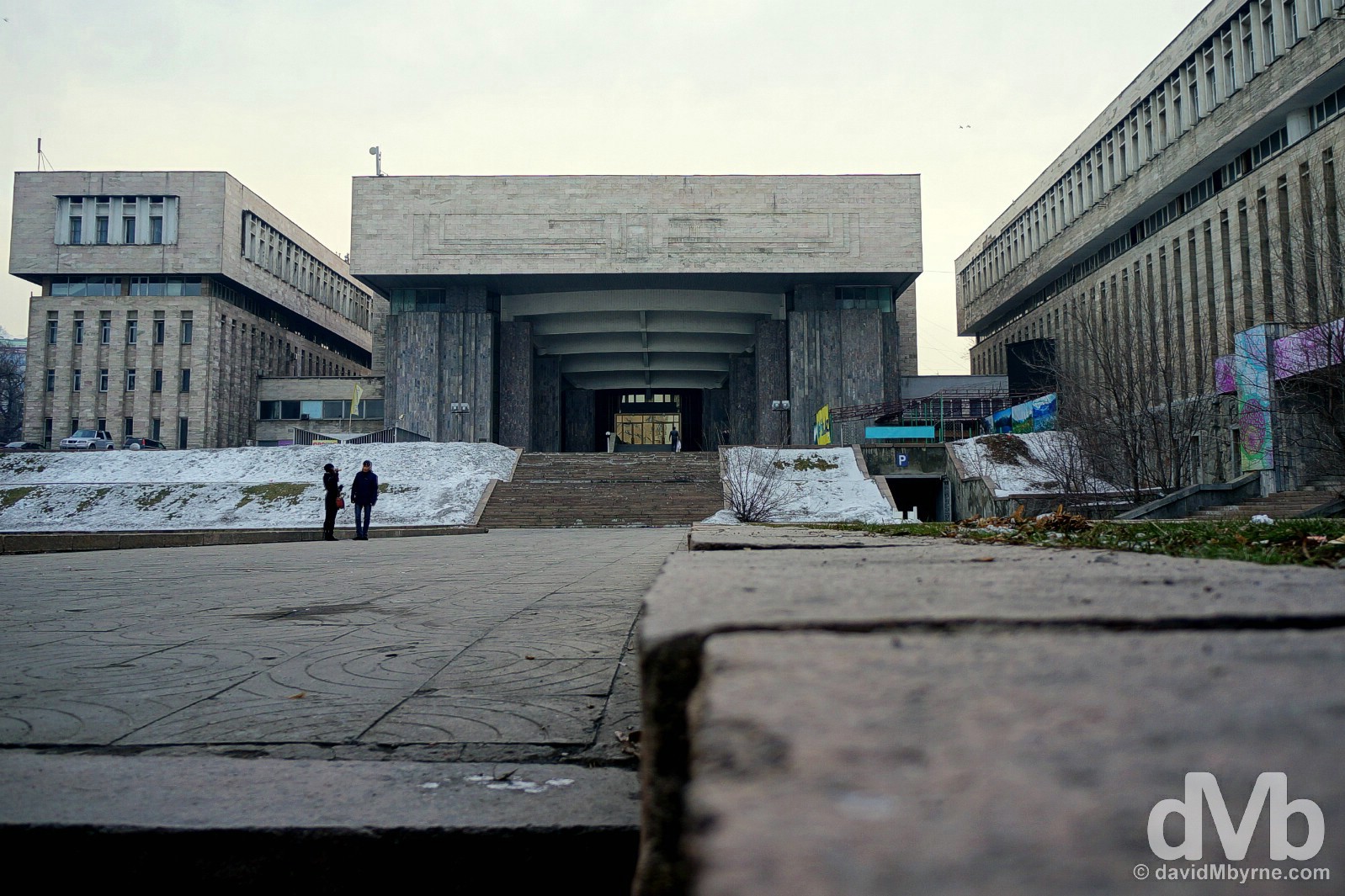
Yes, Almaty is a Soviet-style city & there are more than a few boxy, Soviet-era structures to ogle at. This building in particular caught my attention, maybe because it’s so damn big. Somewhat ironically, and insofar as I could decipher, the building is the headquarters of a branch of the Kazakh government that oversees building and architectural regulation & compliance. Soviet-era architecture on the streets of Almaty, Kazakhstan. February 14, 2015.
I liked Almaty from the get-go. Maybe that was because it was somewhere new and, ahem, it wasn’t China. That said, it didn’t strike me as very photogenic right off the bat – it doesn’t boast many, if any, obvious standout sights or attractions. However, after a few days in the city its obvious charms become apparent. Here’s some of the best of what there is to see.
Panfilov Park

As I’ve said many times before, what’s an (ex) Soviet city without a War Memorial? This is Almaty’s memorial to the fallen. It’s located in the city’s Panfilov Park, named after the Panfilov Heroes, 28 men from Almaty who died fighting the Germans in a village outside Moscow in 1941. There is, of course, the requisite eternal flame but the memorial’s fearsome focal point is a massive sculpture that depicts soldiers from all 15 Soviet-era republics bursting out of a map of the former USSR. It’s an impressive sight. The War Memorial in Panfilov Park, Almaty, Kazakhstan. February 13, 2015.
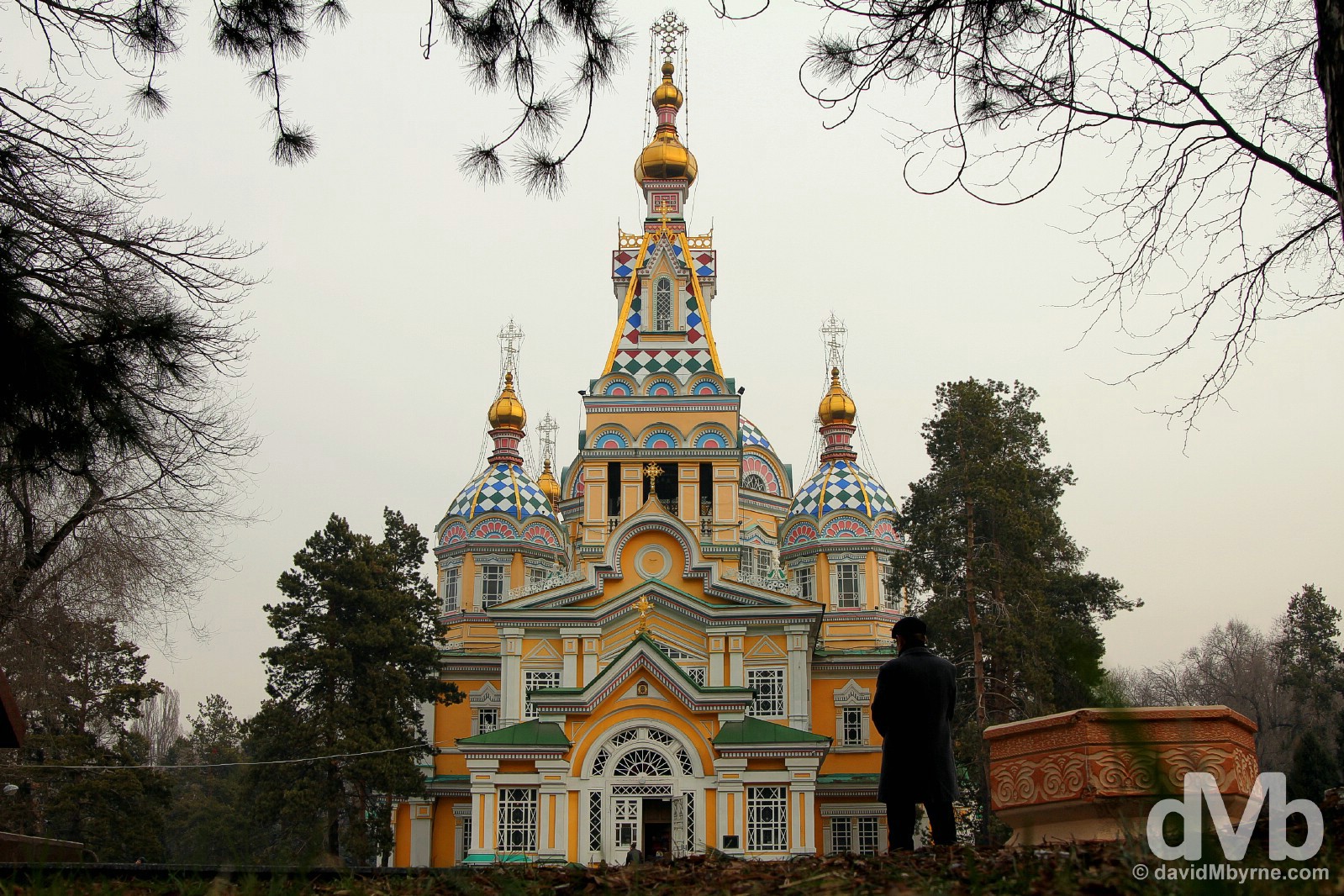
Also in Panfilov Park is Almaty’s very own St Basil’s, the candy-coloured Zenkov Cathedral, a Russian Orthodox church built between 1904 & 1907. Built entirely of wood, including the nails, it’s one of Almaty’s few remaining tsarist-era buildings. It’s exterior is a lot easier on the eyes than the dark, compact interior where photography is not allowed. Zenkov Cathedral in Panfilov Park, Almaty, Kazakhstan. February 15, 2015.
Zhybek-Zholy/Arbat
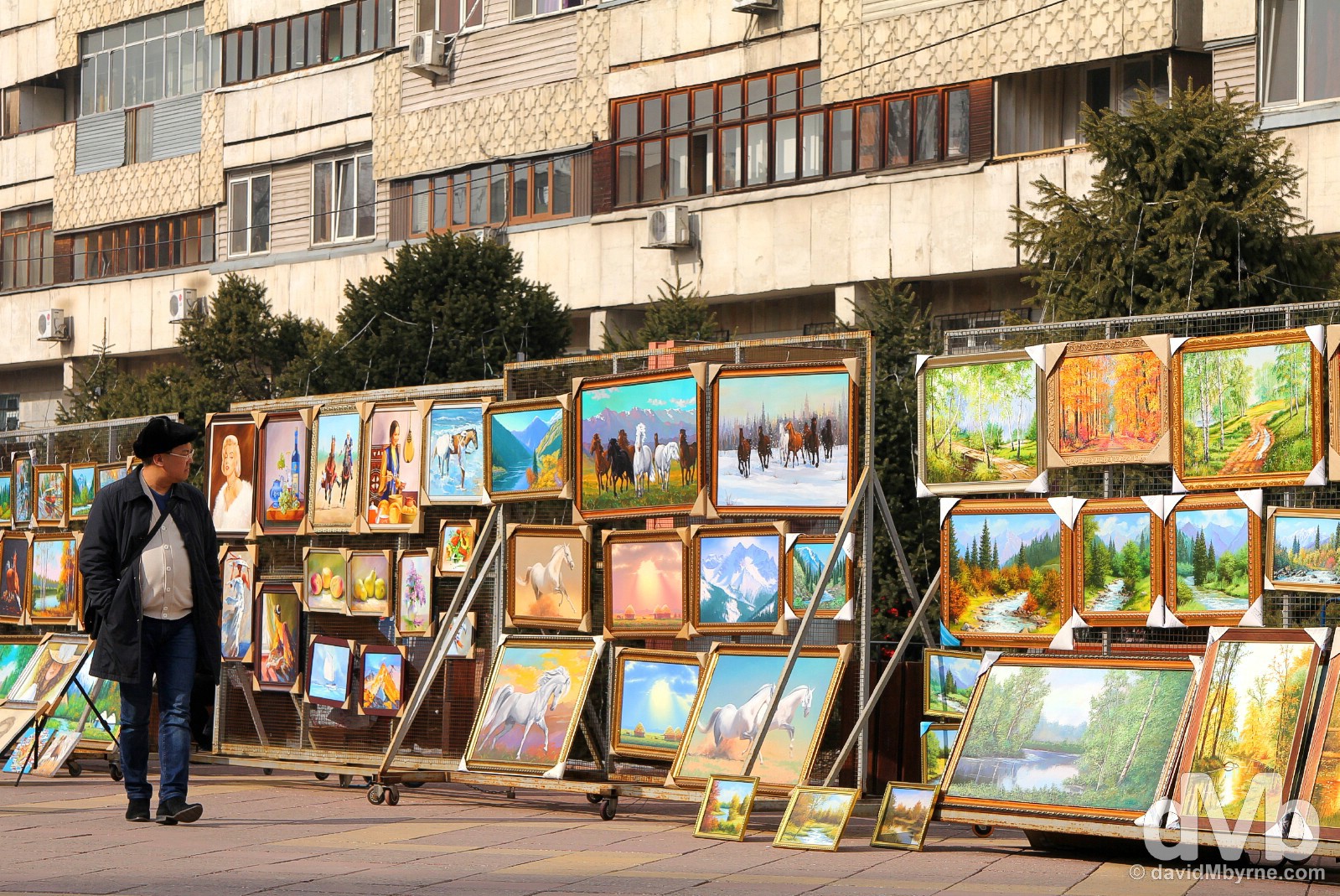
A portion of central Almaty’s Zhybek-Zholy (Silk road) is pedestrianised and lined with art sellers, making it Almaty’s artist row. Also known as Arbat, after the much more famous Arbat in Moscow, it’s also where you’ll find numerous cafes, doner (kebab) stalls & clothing stores. Zhibek Zholy, a.k.a. Arbat, in central Almaty, Kazakhstan. February 15, 2015.
Almaty Metro
I only entered the Almaty Metro system because I was tired of walking on this particular day. And I’m sure glad I did.
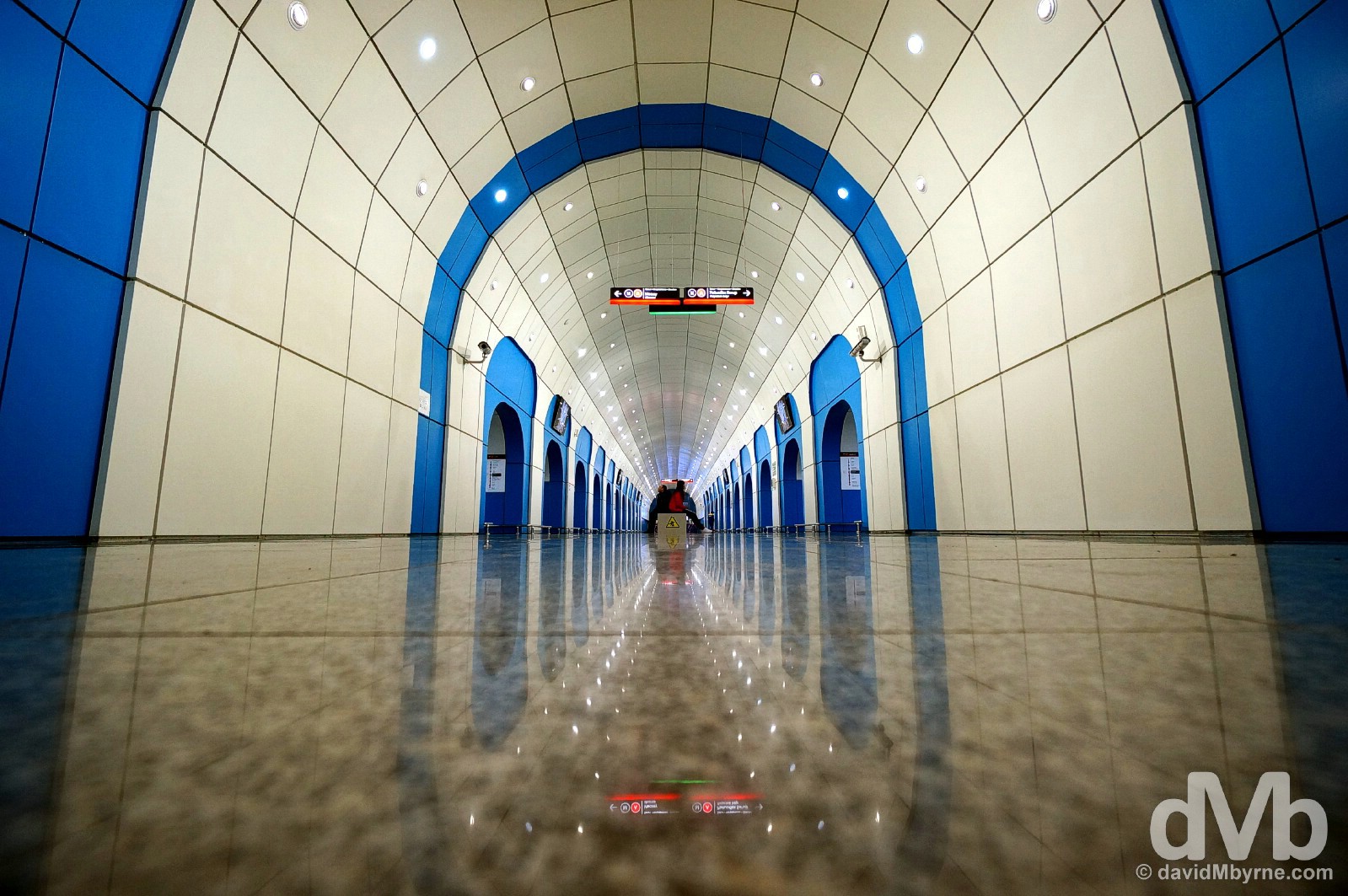
The new (it opened in 2011), cheap as chips (it’s less than €0.40 a ride) Almaty Metro is small (only 7 stations along a single line as of now) but its a sight to behold. Financed by the country’s petrodollar boom, everything about the system, from the street-level entrances to the cars on the tracks, is surgically clean with polished, reflective surfaces a plenty. I’m not sure if photography is allowed down here but I just couldn’t resist introducing my camera to the somewhat psychedelic blue-and-white colour scheme of this, Baykonyr Metro Station. A scoot around all 7 stations is definitely on the cards before leaving the city for good, whenever that happens to be. Baykonyr Metro Station in Almaty, Kazakhstan. February 15, 2015.
Zelyony Bazar (Green Market)
Another city gem was/is this, the Zelyony Bazar, a.k.a. Green Market.
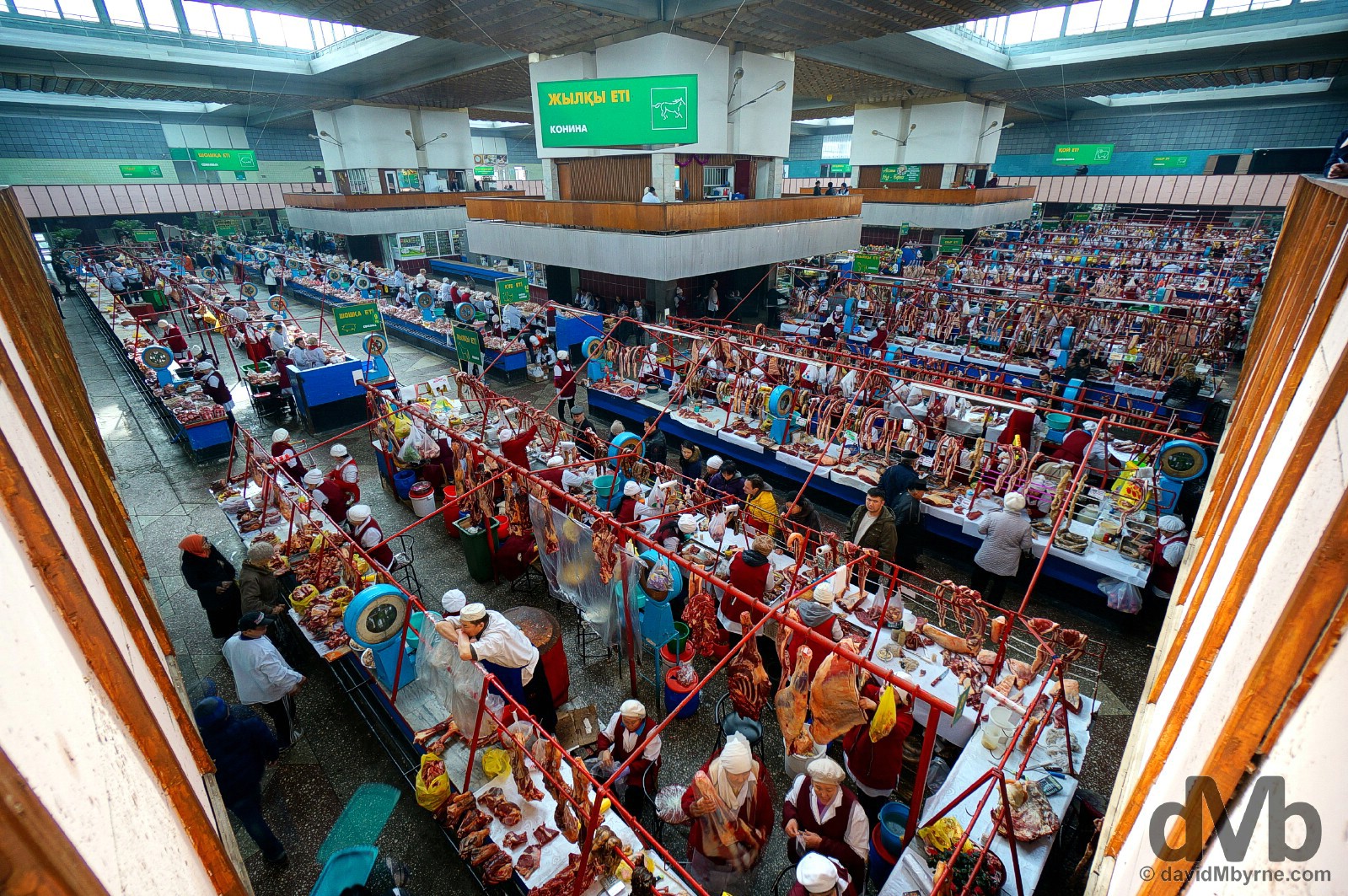
This place, which Lonely Planet claims to have ‘a true flavour of Central Asia‘, sells a lot of stuff, the vast majority of it edible. The buzz on the floor is intense but the second floor walkway circling the market is by far the best place from which to view the buyer-seller action below. Photography in here is frowned upon; I saw the subtle ‘No Photography’ signs upon entering the market but decided to snap away until such time as someone told me not to. That eventually happened but not before I had done my worst. This is a wide-angle overview of the whole market with the horse meat section right below me. Yes, horses have a long and distinguished history of service to the nomadic Kazakhs but even that isn’t enough to prevent them escaping the dinner table. Needs must and old habits die hard. Zelyony Bazar, a.k.a. Green Market, in Almaty, Kazakhstan. February 15, 2015.
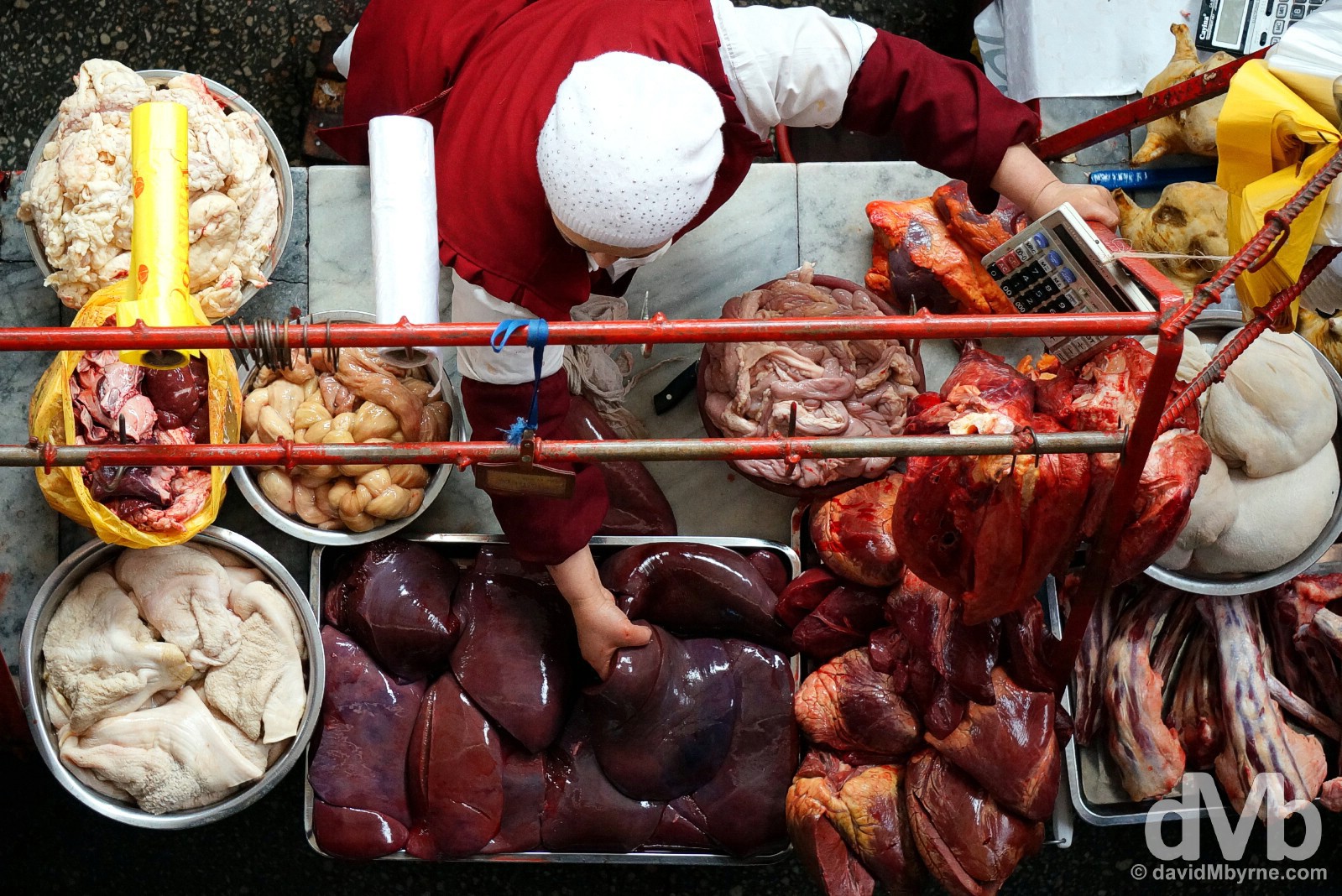
Zelyony Bazar, a.k.a. Green Market, in Almaty, Kazakhstan. February 15, 2015.
Almaty’s not done yet. More from the city in due course.
MEDEU & SHYMBULAK
Date || February 20, 2015
Location || Almaty, Kazakhstan ( )
)
One of the best things about Almaty is the city’s proximity to the snow-capped Zailiysky Alatau range, the northernmost range of the region’s Tian Shan, a large system of mountain ranges that dominates this part of planet earth. The peaks make an impressive backdrop for the city, assuming you can see them. I wasn’t going to venture up into the hills until such time as I got a nice, clear day. I didn’t have to wait too long. I woke on my second full day in the country to glorious clear blue skies and thus hopped on the bus for the 20 minute ride from the city to the Zailiysky Alatau’s Malaya Almatinka valley. In summer it’s a popular hiking, picnicking & mountain biking destination. But this time of year, during the November to April ski season, it’s Almaty’s winter-sports playground.
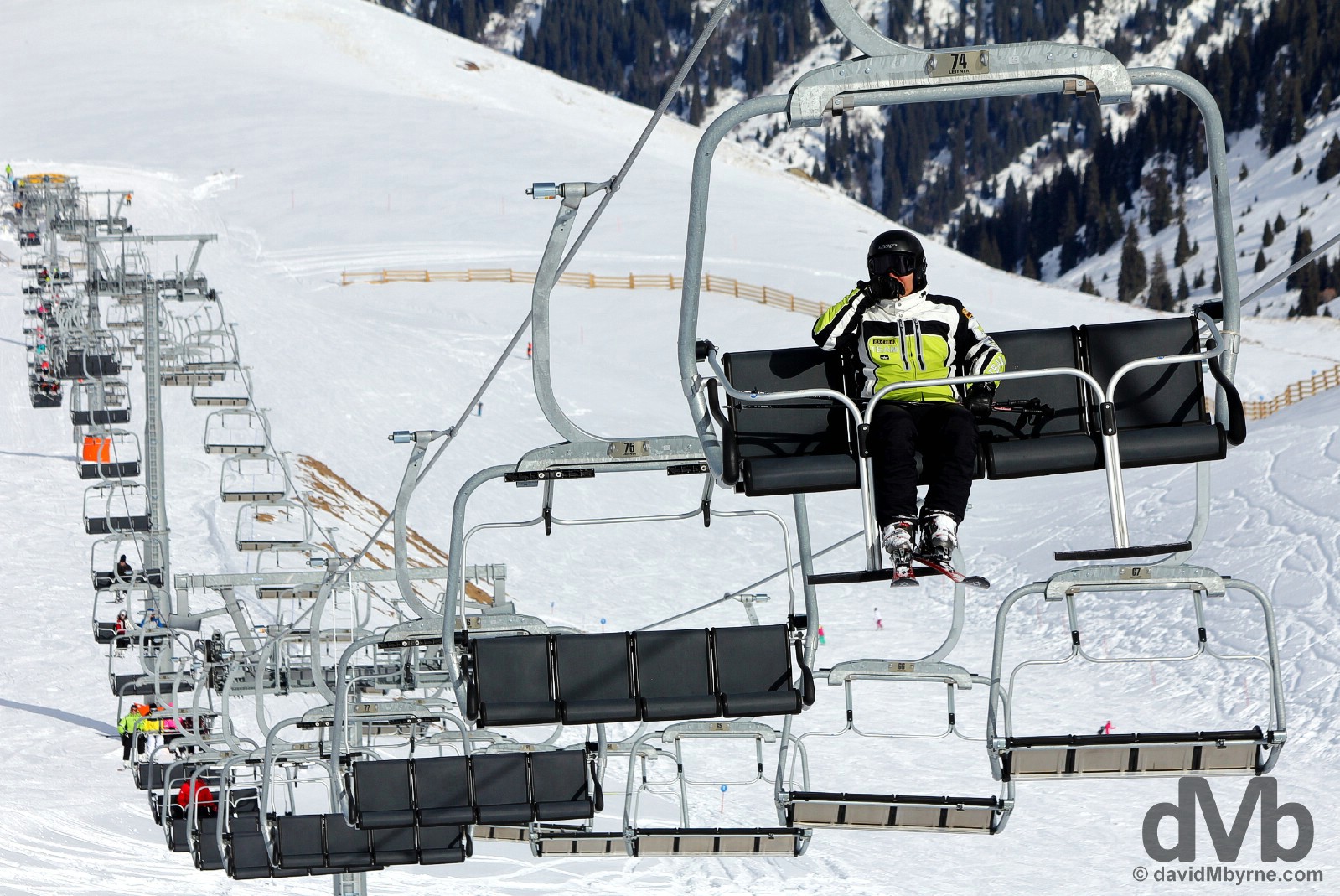
Riding the chairlift near the 3,180-metre high Talgar Pass, the highest point of Central Asia’s premier ski resort, the Shymbulak Ski Resort in the Zailiysky Alatau range outside Almaty, southern Kazakhstan. February 14, 2015.
Medeu & Shymbulak
The bus dropped me off at the lower cable car station in the Malaya Almatinka valley, not far from the Medeu ice rink.
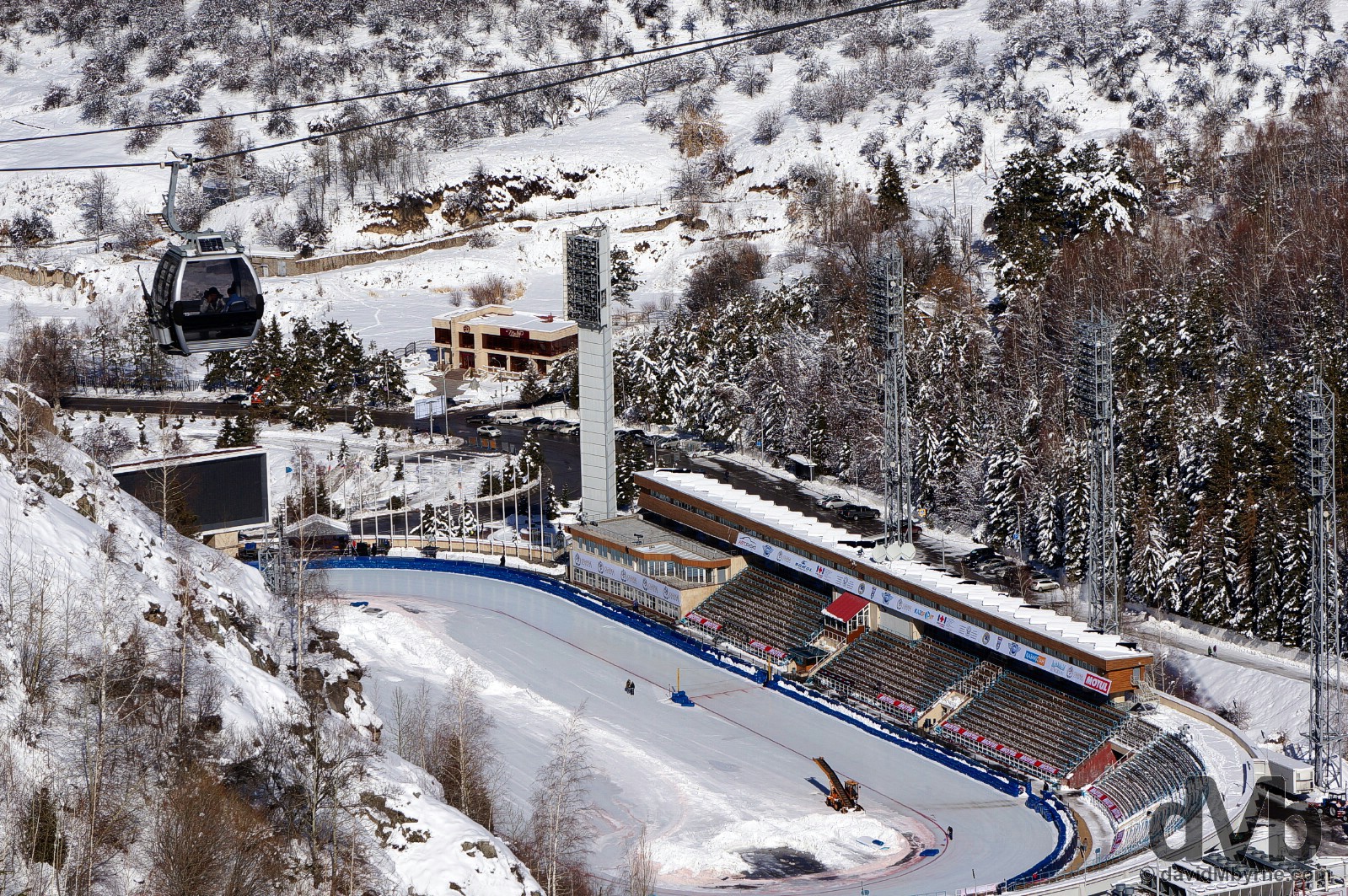
The Medeu ice rink sits at an altitude of 1,700 metres making it the highest Olympic sized rink in the world. It’s also one of the biggest, boasting a whopping 10,500 m² of ice coverage. It was built in 1972 specifically for speed skating. Many a who’s who of the sport have trained here and over the years it has been the setting for more that 180 world records. I took this picture from my gondola of the cable car system en route to the base station of the Shymbulak Ski Resort, some 4.5 kilometres further up the valley from the ice rink. Malaya Almatinka valley, Zailiysky Alatau range, southern Kazakhstan. February 14, 2015.
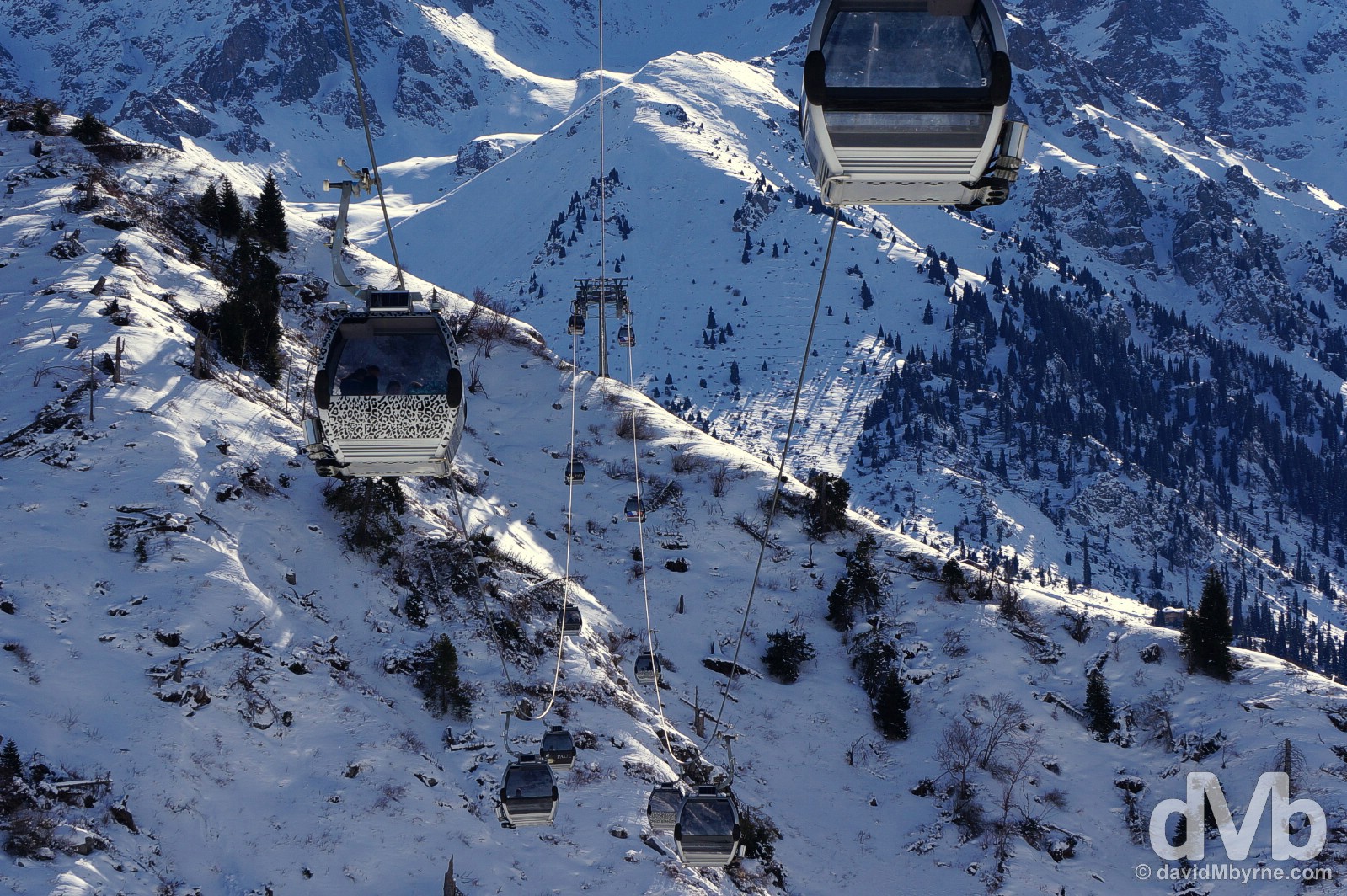
The Shymbulak Ski Resort cable car is 4.5 kilometres in length making it the world’s third longest cable car system. It was installed in 2011 as part of a massive resort upgrade ahead of the 2011 Asian Winter Games, for which Almaty was the host city. There are 114 gondolas/pods in total and the trip from the base to the ski resort sees you glide in almost silence through an alpine wonderland for about 25 minutes. The Shymbulak Ski Resort cable car system on the slopes of the Zailiysky Alatau range in southern Kazakhstan. February 14, 2015.
The cable car deposits you at the 2,260-metre high base/main station of the Shymbulak Ski Resort, Central Asia’s premier ski facility with over 3,600 metres of runs for all levels of skiers. From the base station, 6 ski lifts, named Combi 1 & Combi 2, ferry skiers, and non-skiers, further up the slopes to the 2,840-metre high Middle Station, & even further still to the highest point of the resort, the 3,180-metre high Talgar Pass.
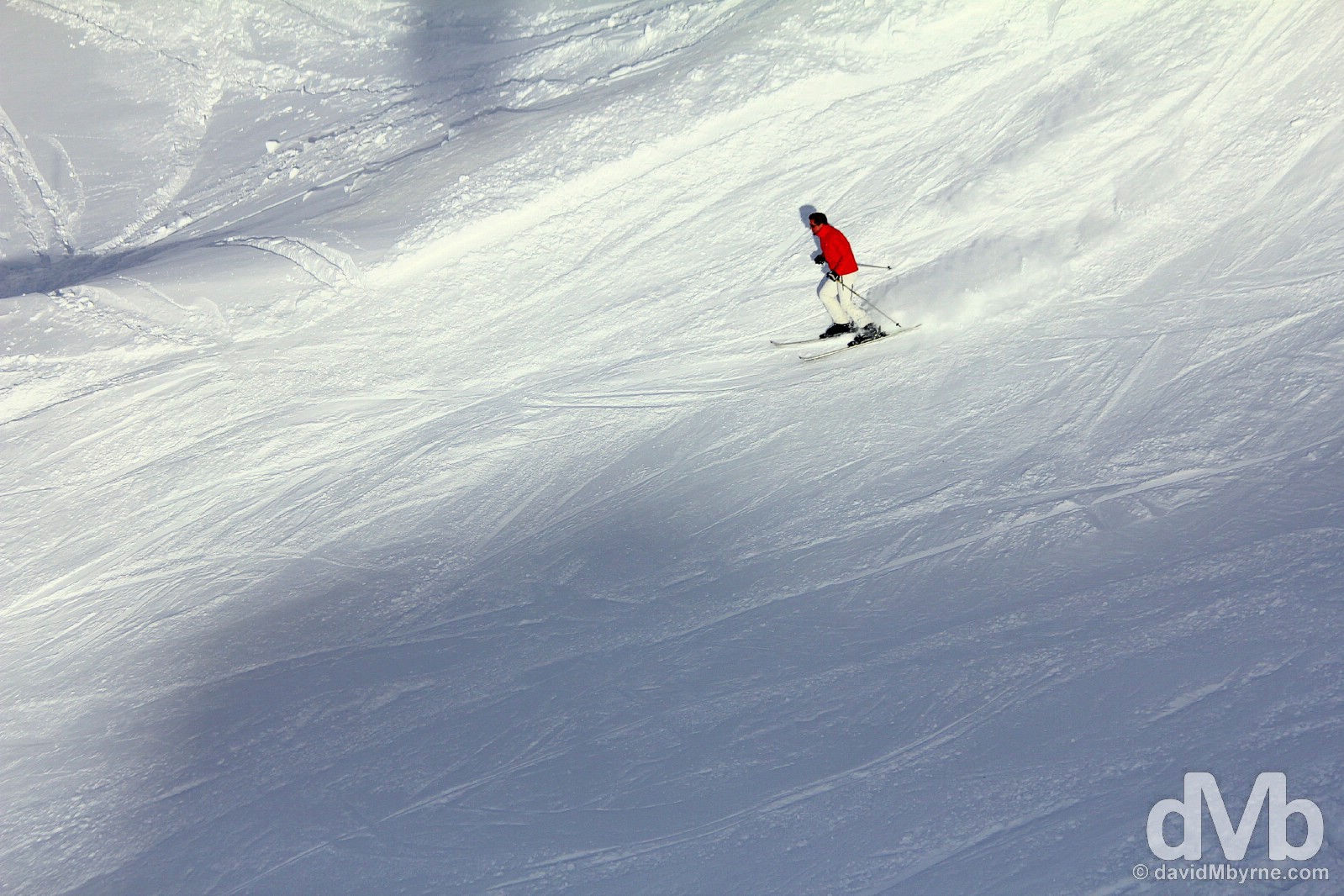
A skier as seen from the ski lift, Combi 1, connecting the resort’s base & middle stations. Zailiysky Alatau range, southern Kazakhstan. February 14, 2015.
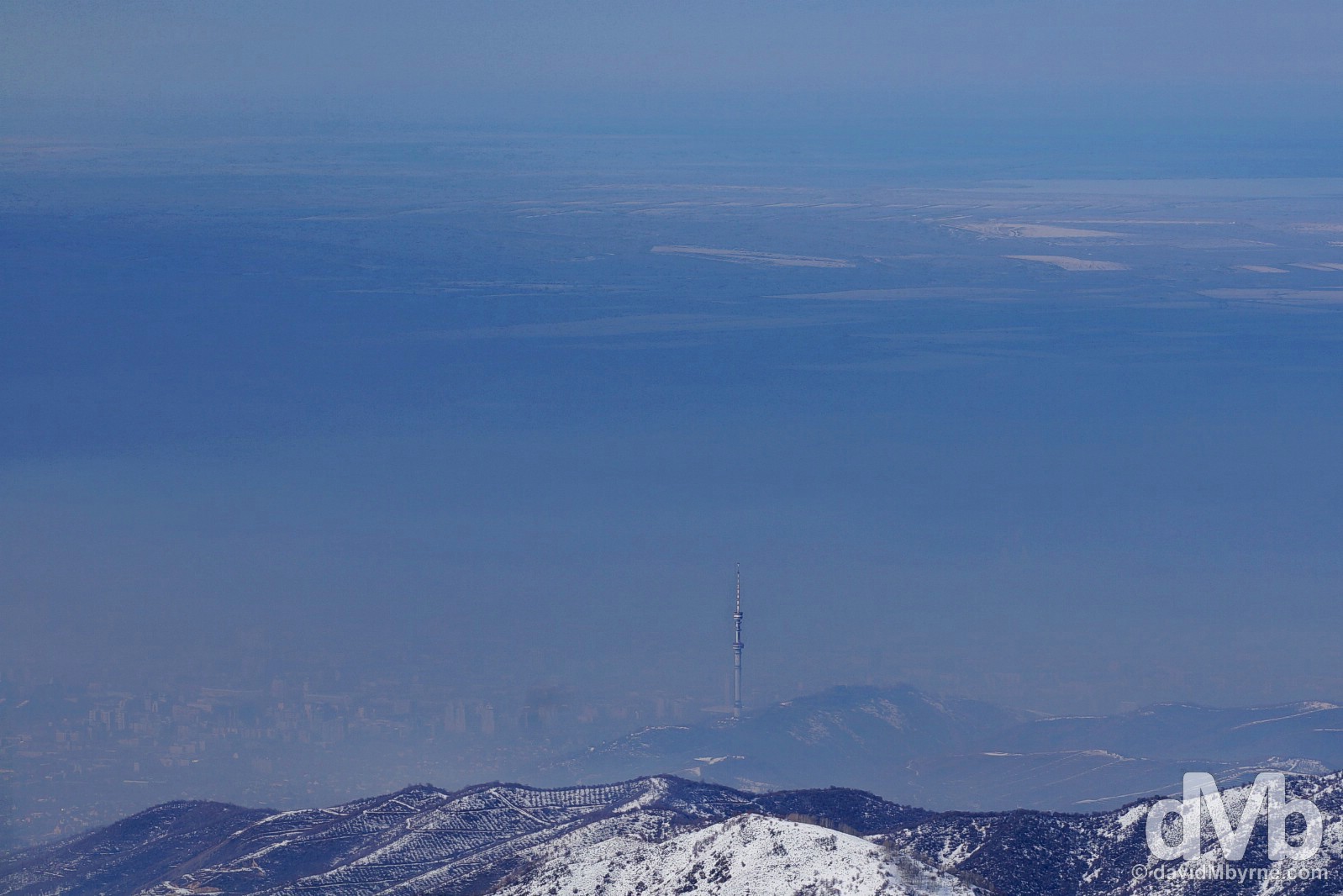
The distinctive landmark of the 372-metre high TV & communications tower & the city of Almaty as seen from the 2,840-metre high middle station of the Shymbulak Ski Resort in the Zailiysky Alatau range in southern Kazakhstan. February 14, 2015.
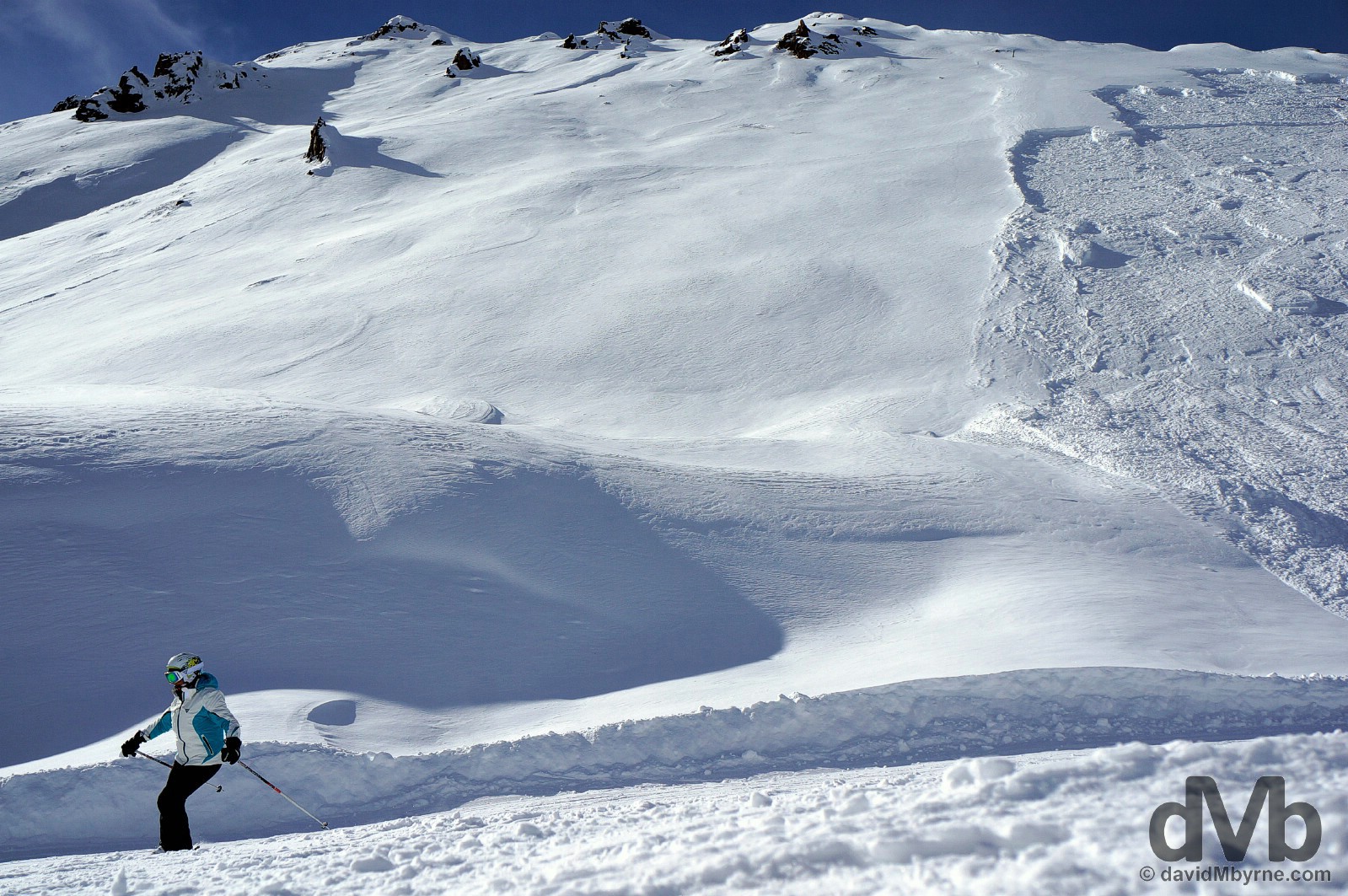
Setting out on a run from the 3,180-metre high Talgar Pass, the highest point of the Shymbulak Ski Resort. It was chilly up here, a marked difference in temperature from the lower reaches of the resort. I was about the only non-skier around these parts. That drew some strange looks so I can only imagine what the locals thought of me venturing out onto the runs with a camera in hand. The views here were awesome, especially of massive glaciers resting in surrounding valleys. Geographically this isn’t too far from the border with neighboring Kyrgyzstan. In fact, during the summer months people hike over the hills here to Kyrgyzstan’s Lake Issyk-Kot, something it’s prohibited for foreigners to do. On the Talgar Pass of the Zailiysky Alatau range in southern Kazakhstan. February 14, 2015.
ASTANA
Date || February 21, 2015
Location || Almaty, Kazakhstan ( )
)
Well, and unlike Almaty, no one is going to mistake the Kazakh capital of Astana for a Soviet city, at least not the ‘new’ Astana. From what I’ve seen of Russia they don’t have anything like this place. But I guess that’s the whole point.
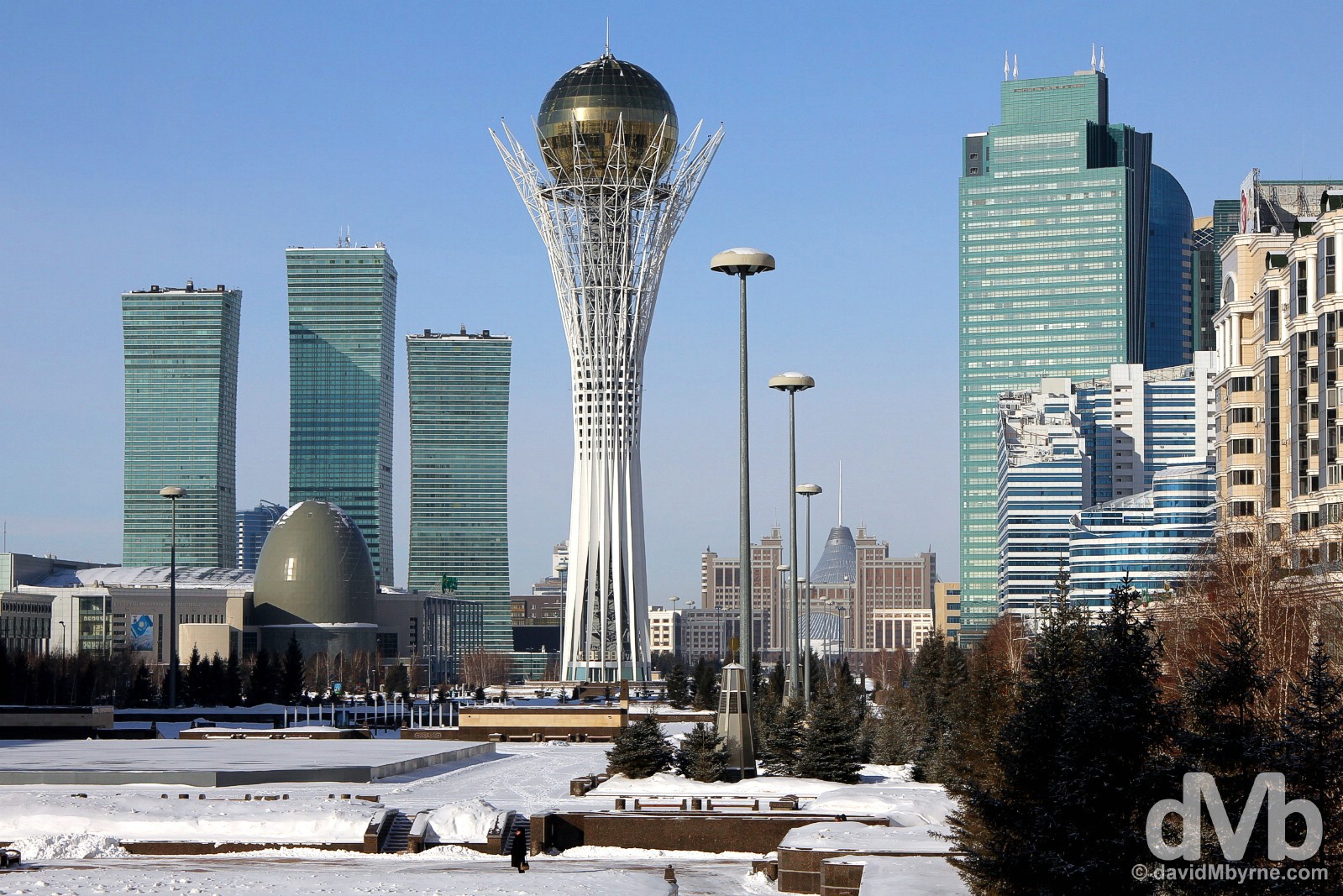
Looking west up Nurzhol Bulvar, Astana’s new city showpiece, a 2-kilometer long governmental & monumental zone of gardens & plazas lined with an array of 21st century buildings. Sitting proudly in the centre of all this is the 97-metre high Bayterek Monument, probably the city’s most iconic landmark (for now). Astana, Kazakhstan. February 18, 2015.
Northern Kazakhstan is the Kazakh heartland where the Eurasian steppe meets the Russian sub-Siberia. And it’s here you’ll find the city of Astana, situated slap-bang in the middle of the windswept northern Kazakh steppe, a.k.a the bona fide middle of nowhere. There has been a settlement here since as far back as 1830. The town grew, and grew, and grew, mostly on the northern bank of the city’s Ishim River, but remained a place that (understandably) didn’t garner much attention. That all changed in 1994 when the Kazakh President, Nursultan Nazarbayev, named it out of the blue as the location for the shiny new capital. It officially took over the reins as capital from Almaty in December 1998 and frenzied building has been taking place ever since. Billions have been spent thus far, financed by Kazakhstan’s petrodollar boom, & billions more will be spent in the coming years & decades as the city continues its transformation into a 21st century hub of modernity, a bold showpiece capital for Central Asia boasting a profusion of futuristic architecture from world-renowned architects.
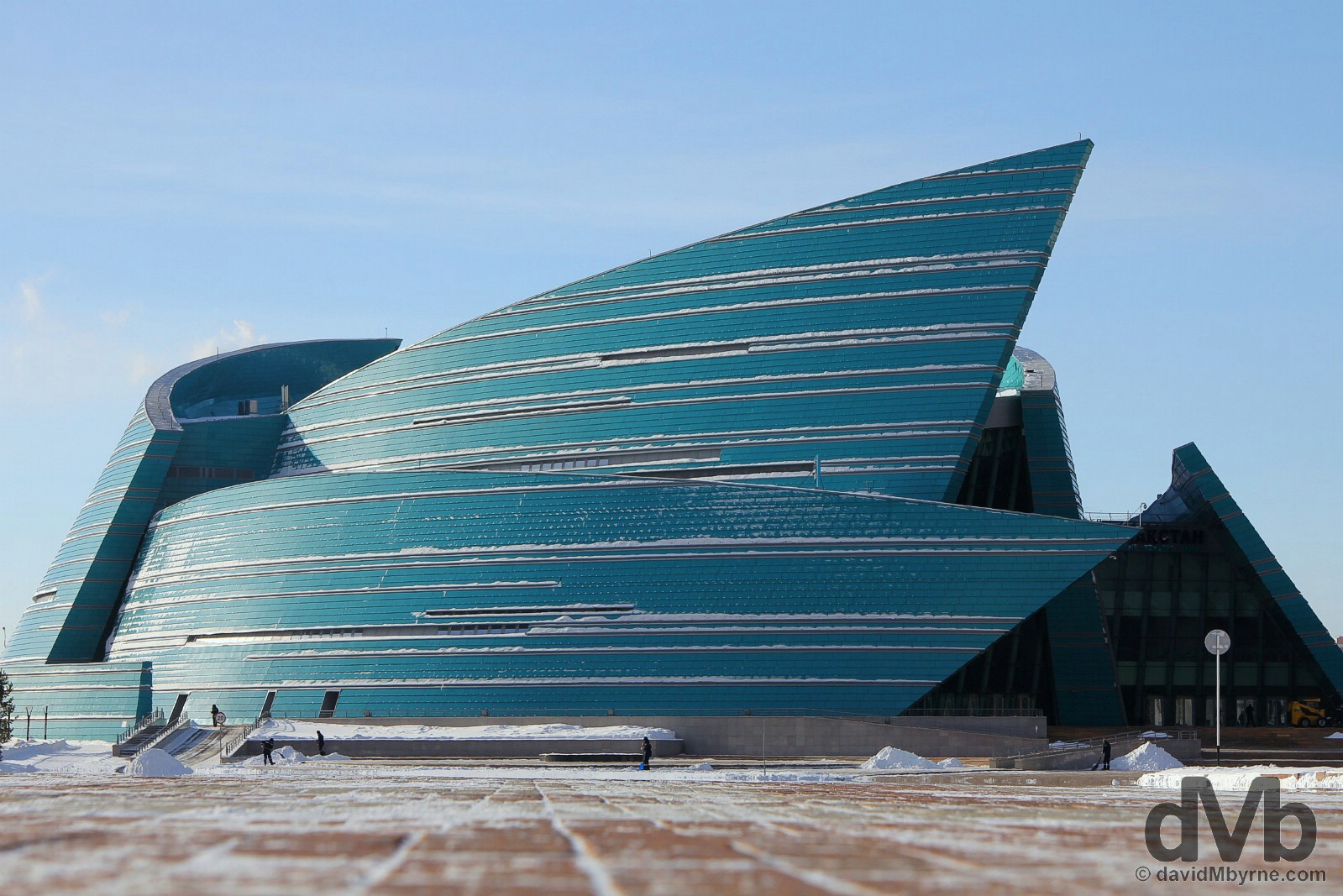
Clearing snow at the base of the Central Concert Hall, just one of the many extraordinary new buildings in the new Astana. Opened in 2009, it cost a cool €120 million & boasts over 55,000 m² of floor space. Astana, Kazakhstan. February 18, 2015.
The Dubai of The Steppes
Some find Astana, the so-called Dubai of the Steppes, an impersonal place. I get that. It’s undeniably sterile with little to no sense of history or culture. Add to that the fact that there isn’t one historic or must-see sight. But none of that matters here. It’s the sheer concept of the place and the ambition to put it all together that is Astana’s drawing card, or at least it was for me (& that’s why I took 2 overnight high-speed train journeys to get here from Almaty, a 2,500 kilometre round trip). I spent 2 nights in the city, good for almost 3 full days of walking up and down Nurzhol Bulvar, checking out the architecture, & fending off hypothermia – most who venture here do so in the summer and while I advocate out of season travel and love the cold/ice/snow, -34 Degree Celsius temperatures combined with biting steppe winds might not be to everyone’s liking.
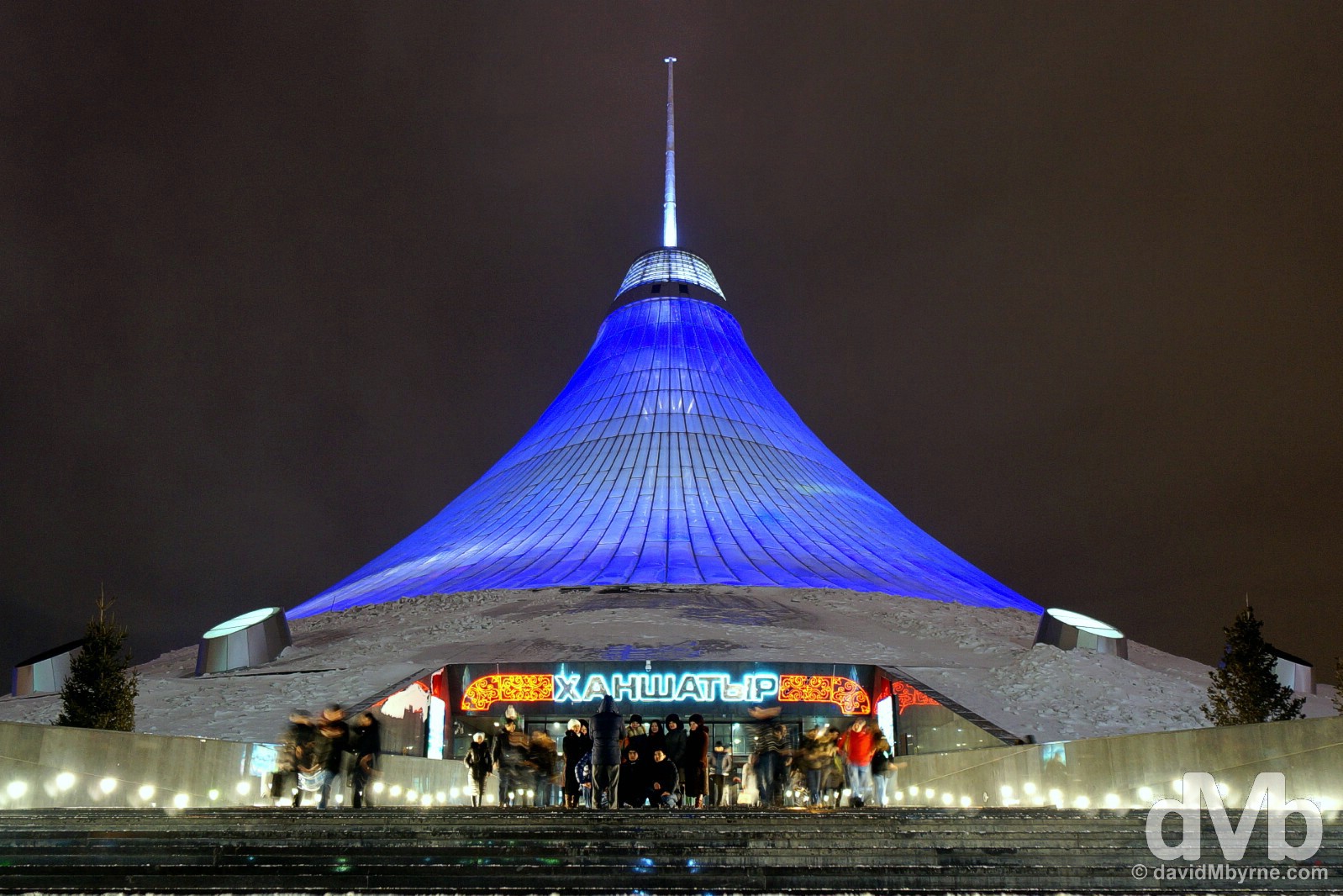
One end of the 2-kilometre long Nurzhol Bulvar is marked by the new Presidential Palace, the other end by this, the €350 million Khan Shatyr, probably the city’s most bizarre building. Opened in 2010, it’s a 150-metre high translucent circus tent-like structure with a 200 metre elliptical base, the (warm) innards of which house a multilevel shopping mall & entertainment complex. Oh, & the upper levels house the Sky Beach Club where you’ll find a swimming pool with a sandy beach & palm trees. Yep, a little bit of the tropics housed in the world’s largest tent in the middle of the bitterly cold (in winter) Eurasian steppe. Honest. I captured this image on my first night in the city. The weather during the day wasn’t great (it was dull and overcast) so my keeper shots from this day are nighttime captures like this one. Astana, Kazakhstan. February 16, 2015.

A nighttime view of the Bayterek Monument, a 97-metre high white latticed tower topped by a 22-metre diameter golden glass orb. The structure, built in 1997, embodies the Kazakh legend in which a mythical bird, Samruk, lays a golden egg containing the secrets of human desires and happiness in a tall poplar tree, beyond human reach. Umm. Bit of a tease really. Astana, Kazakhstan. February 16, 2015.
There is more to Astana than just Nurzhol Bulvar & it environs, even without venturing into the old centre north of the Ishim River, the original Astana. I did venture over the Ishim River a few times to see the glass-and-steel pyramid of the Palace of Peace & Accord, the Kazak Yeli Monument, the Hazret Sultan Mosque & the new uber-impressive marble & glass National Museum. All were either closed (the Palace), underwhelming (the monument) or just didn’t photograph well (the mosque & museum, although the biting cold might have curtailed my photography somewhat). So the Kazakh capital for me was indeed all about Nurzhol Bulvar & it environs. Here are a few more pictures, all captured on my last day in the city, the only blue sky day I was treated to but one that came with the aforementioned -34 Degree Celsius temperatures. I could tolerate the -17 & -12 degree temperatures of the previous, overcast days but on this particular day my camera stopped working a few times (and so did my fingers), my contact lenses almost shrivelled up, & I was unable to stay outside for more than 20 minutes without seeking shelter. I’d never experienced cold like it.
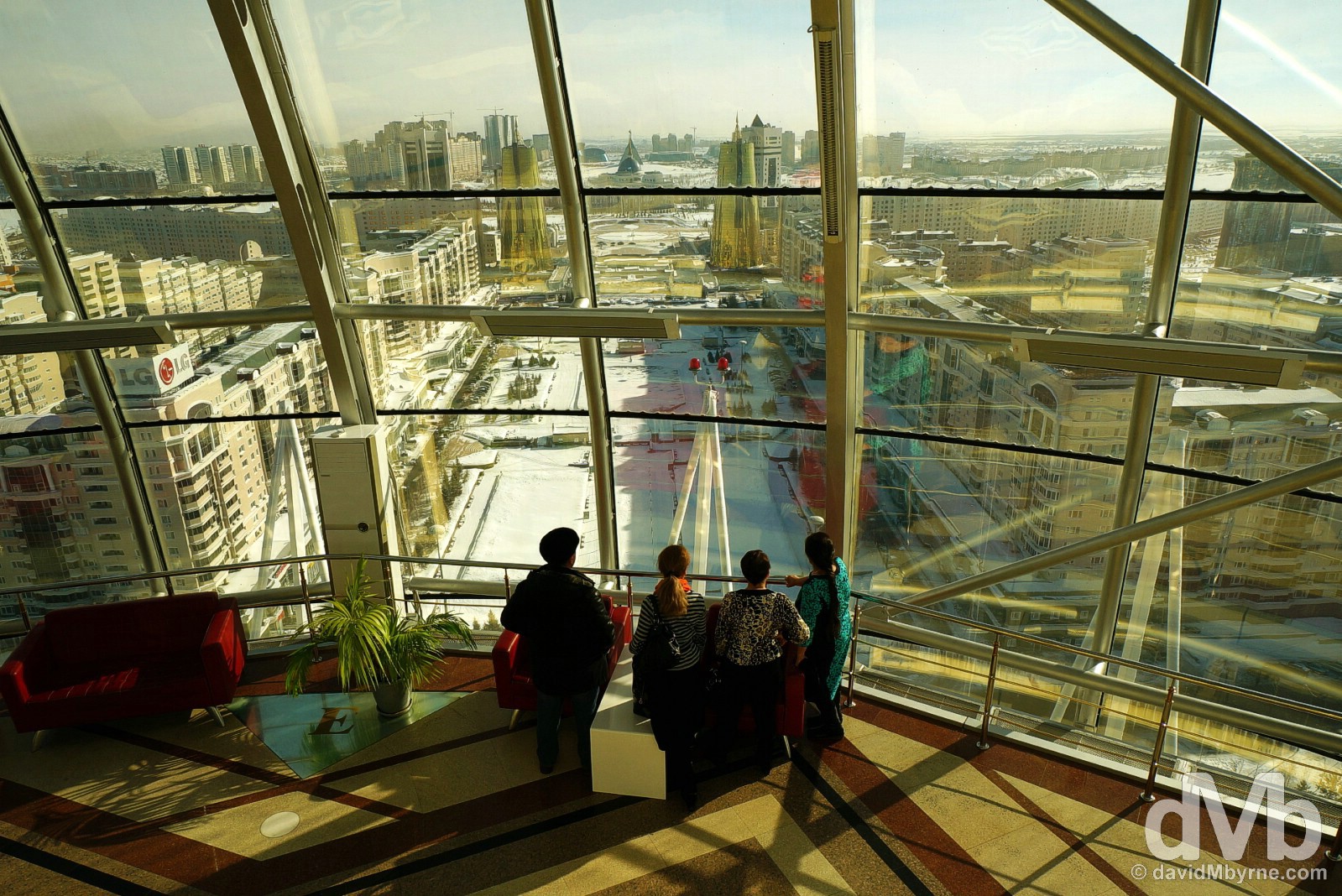
One instance of taking shelter from the cold was by paying a visit to the observation deck of the 22-metre wide golden orb of the Bayterek Monument to enjoy the views. The structure doesn’t look that high from street/ground level but the gold-tinted views of the new city from within the orb are impressive. The lower level of the orb’s 2-tier observation deck has a model of how the finished city will look (scheduled for 2030) while the upper tier contains a platform upon which rests a gold cast of President Nazarbayev’s hand print. People were lining up to match hand sizes with the man himself. Me? I was content with taking photographs like this one of people looking east up Nurzhol Bulvar towards the Presidential Palace & beyond to the Palace of Peace & Accord. Beyond all of that stretch a sea of cranes, busy building the new city. Inside the Bayterek Monument in Astana, Kazakhstan. February 18, 2015.
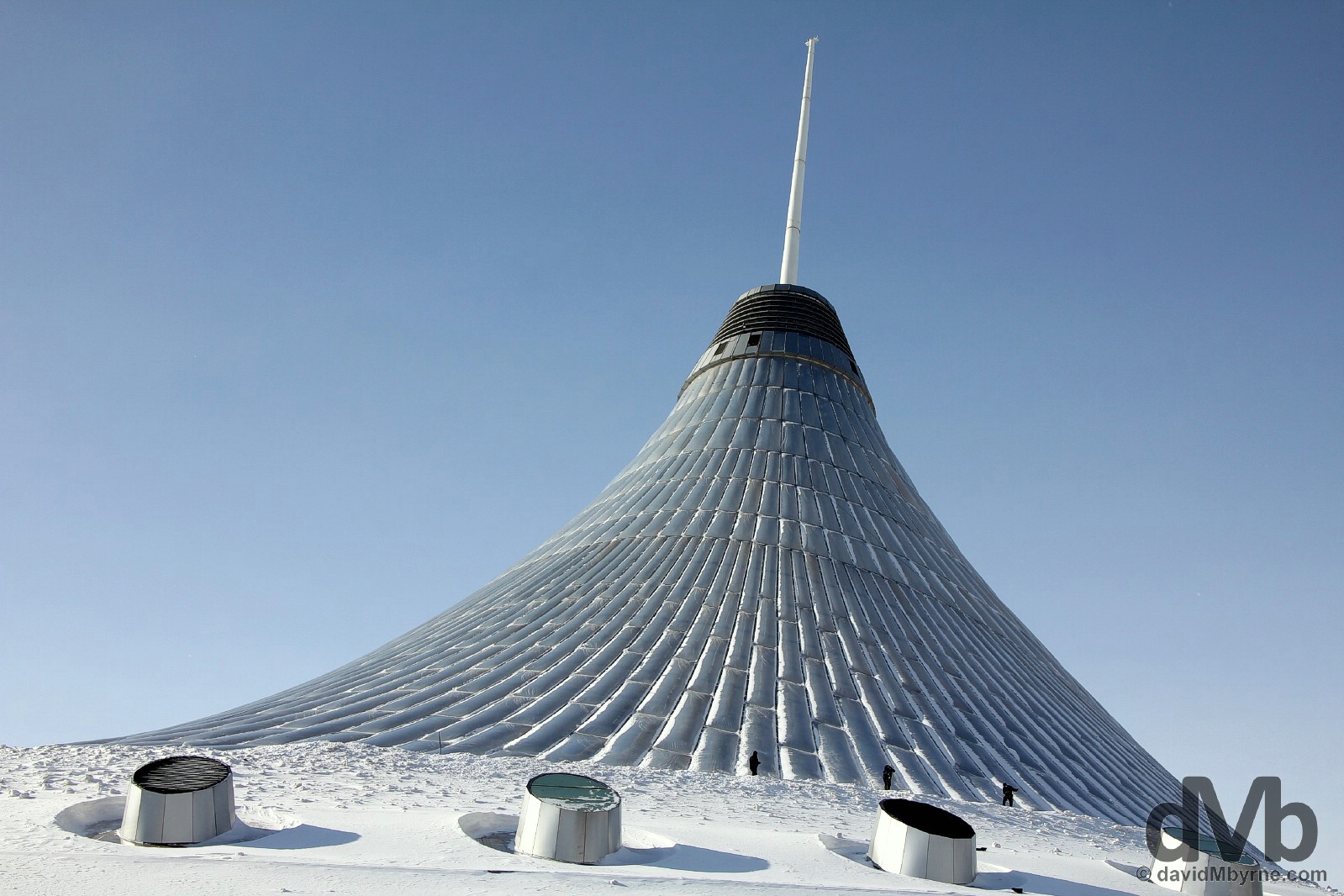
It’s a tough job in these temperatures but someone has to do it. Workers clearing snow from the rim of the roof of the Khan Shatyr. Astana, Kazakhstan. February 18, 2015.
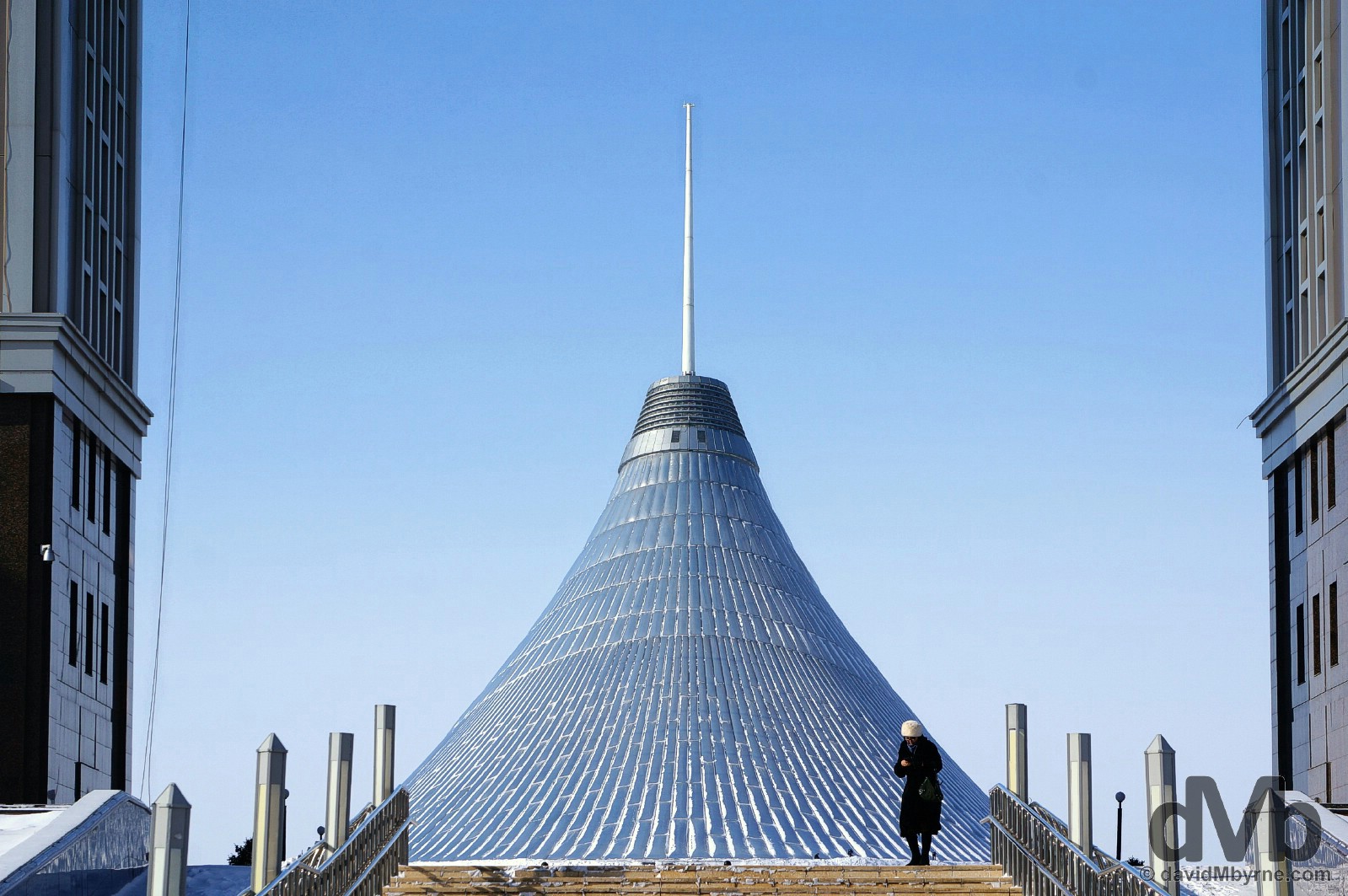
The sloped roof of the Khan Shatyr as seen from under the arc of the KazMunayGaz Building, the headquarters of the state energy company. Astana, Kazakhstan. February 18, 2015.
ALMATY 2
Date || February 22, 2015
Location || Bishkek, Kyrgyzstan ( )
)
I had a few days to kill in Almaty post Astana. I was waiting for a visa to come through. It did and I left the city, & Kazakhstan, earlier today for pastures new, that being Bishkek, the capital of vowel-challenged Kyrgyzstan, my present location & Central Asia country number 2. More from this nirvana of Soviet concrete in good time but in the meantime here are a few parting shots from Kazakhstan that I took over the last few days while killing time in Almaty.

Don’t worry, be happy. Balloons for sale in front of Zenkov Cathedral in Panfilov Park, Almaty, Kazakhstan. February 19, 2015.
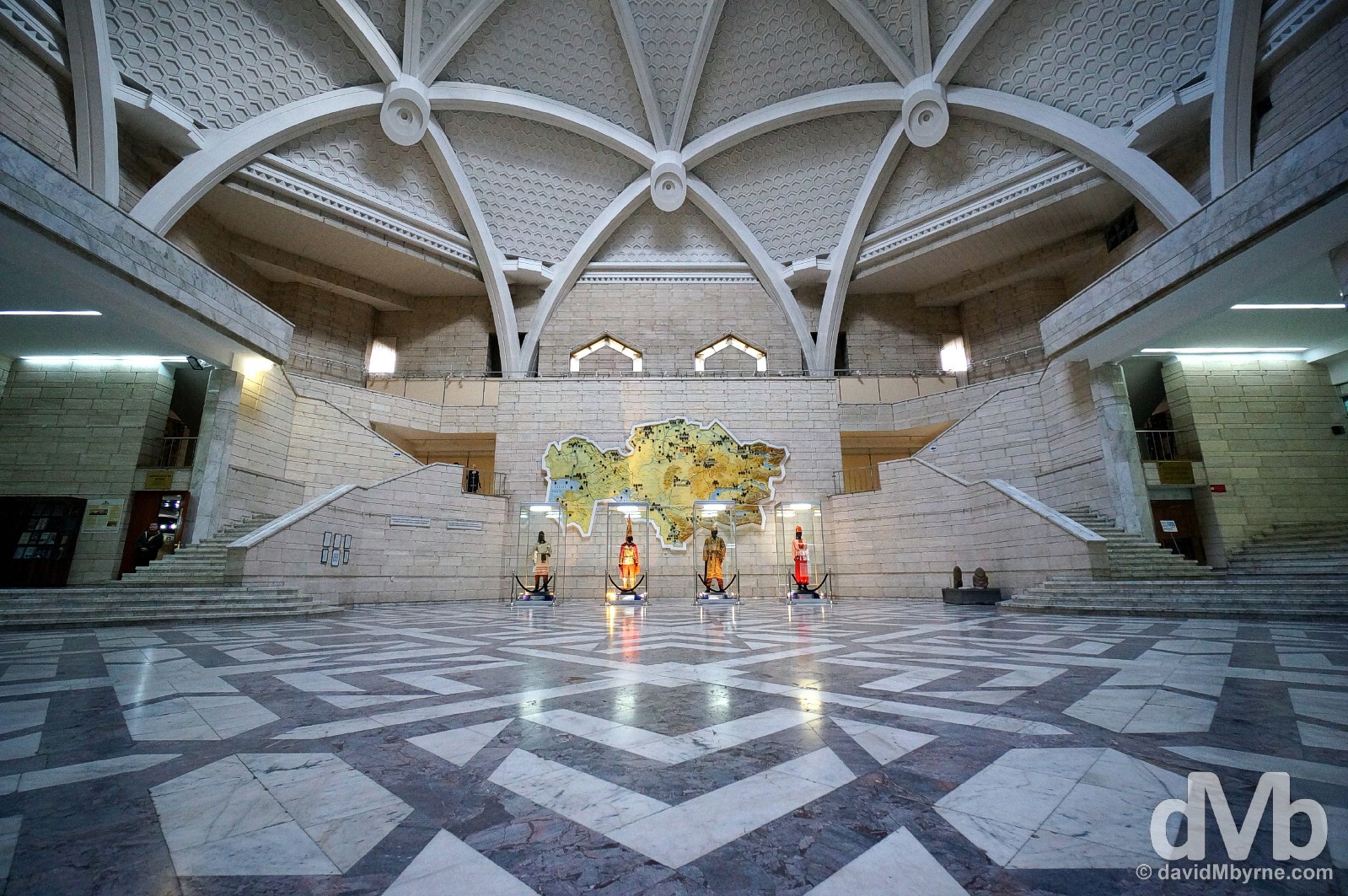
Almaty’s ho-hum Central State Museum is supposedly the city’s best. If so I pity the rest of them. At least its foyer was impressive, although I had to spend extra on top of the entrance fee just to take this shot. Central State Museum, Almaty, Kazakhstan. February 19, 2015.
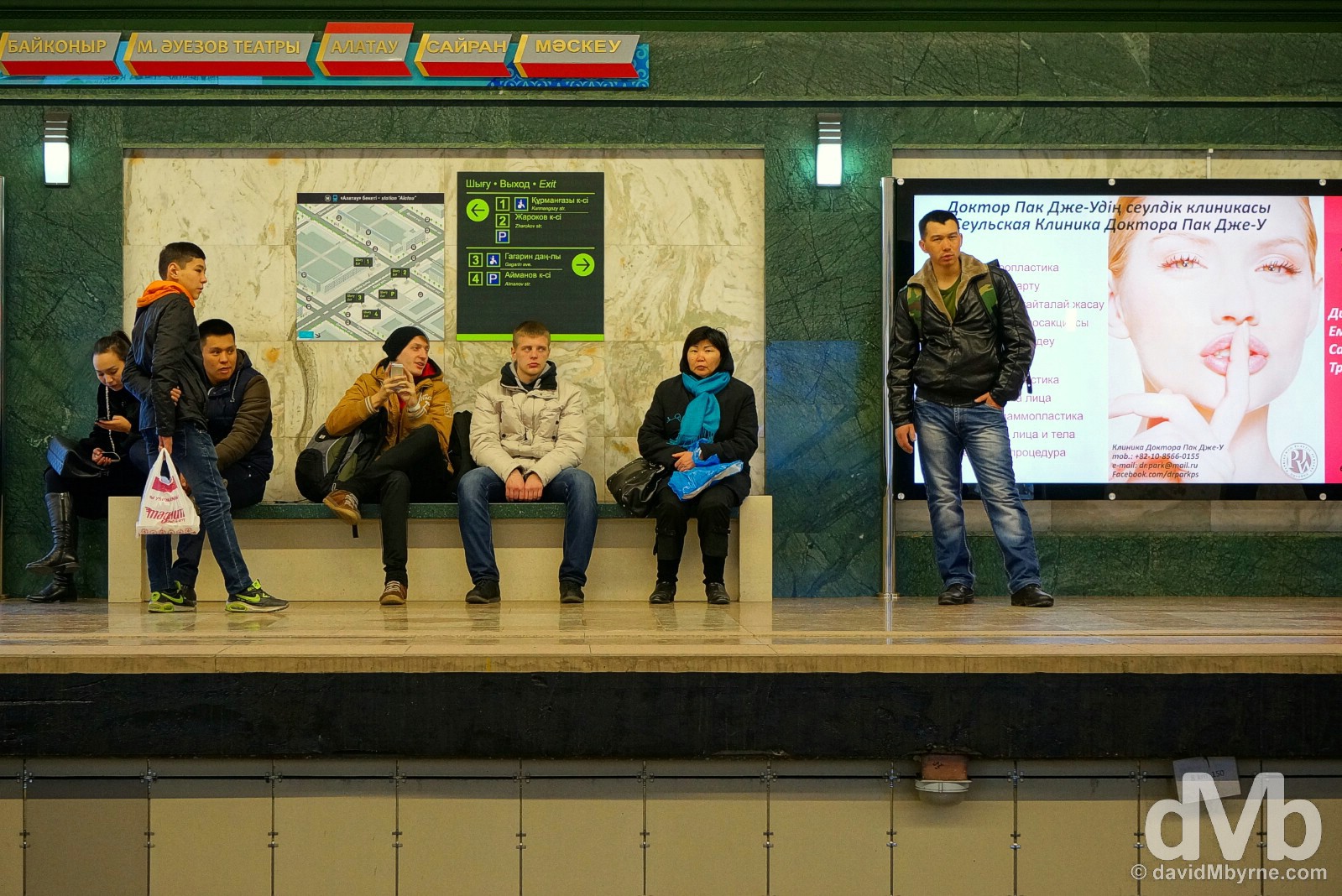
I did do a tour of Almaty’s new metro system, just like I said I would in an earlier posting from the city. It didn’t take long. This was just one of many shots I got during my subterranean exploits, that of passengers waiting on the platform of Alatau Metro Station. Almaty, Kazakhstan. February 21, 2015.
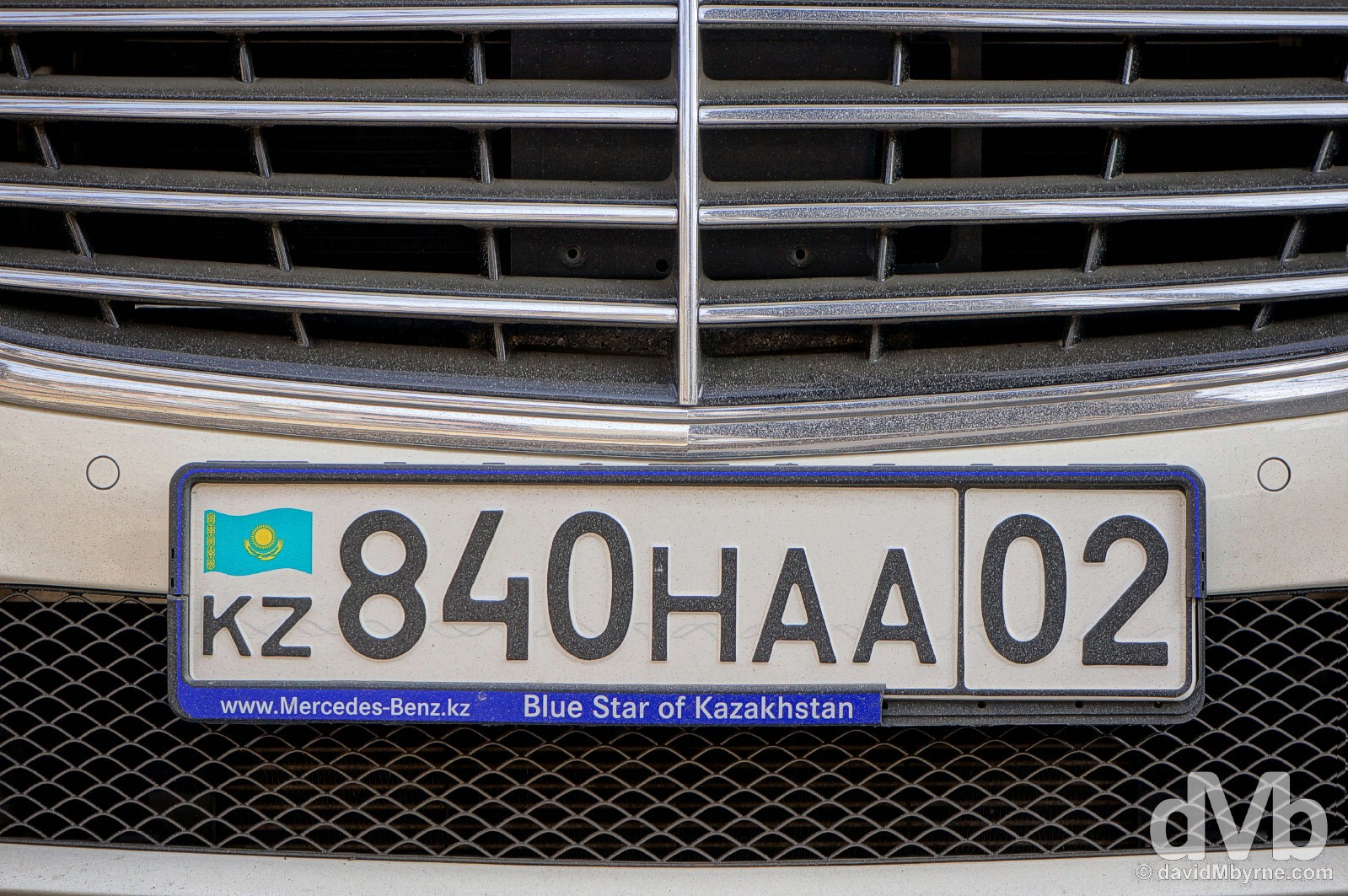
A license plate from Central Asia country number 1. On the streets of Almaty, Kazakhstan. February 21, 2015.
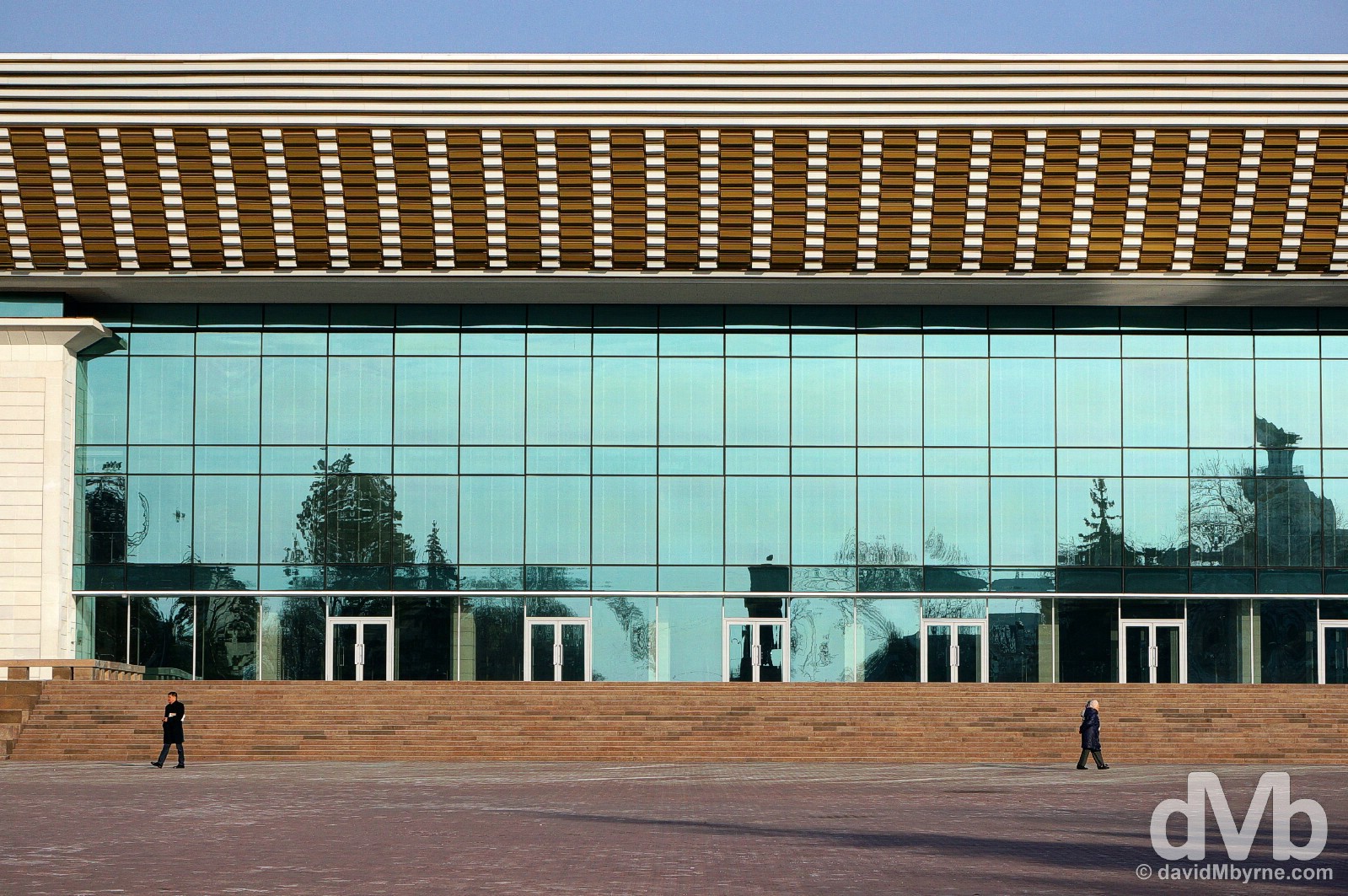
I passed this hulk of concrete & glass, the Palace of the Republic, numerous times during my days in Almaty. I photographed it a few times but it was looking its sunlit best on my last day in the city. Built in 1970, it is used to stage assorted musical events including pop concerts. The Palace of the Republic, Almaty, Kazakhstan. February 21, 2015.
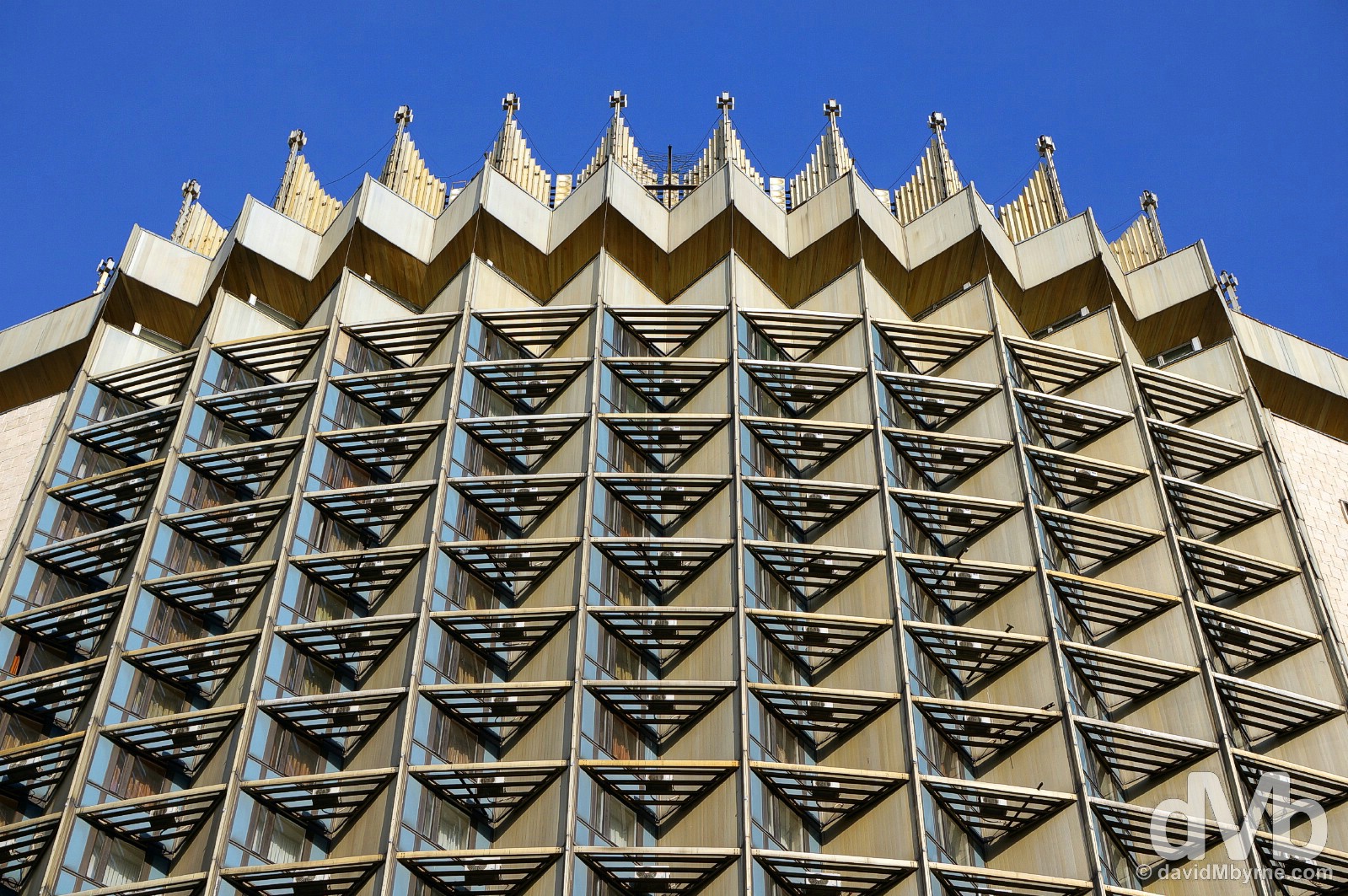
The upper floors of the Hotel Kazakhstan. The earthquake proof building, built in 1970 along with the neighbouring Palace of the Republic, has 26 floor and stands 102 metres high making it the second tallest building in the city. It’s a city and Kazakh icon, so much so that it makes an appearance on the Kazakh 5,000 tenge (€24) note. Almaty, Kazakhstan. February 21, 2015.
